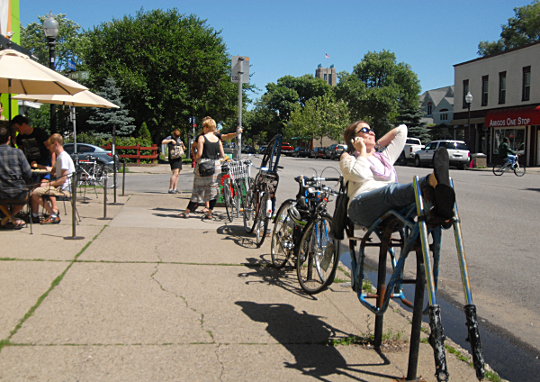
(Photos: M.Andersen/BikePortland)
Now, don’t get me wrong: Minneapolis is a great place to ride a bicycle.
It has lots of things that Portland can and should learn from. And yes, those things they do in the November snow and the August sweat are seriously impressive. But is Minneapolis a better biking city than Portland?
Don’t be silly. It is not.
This post is not a rag on Minneapolis, one of the most successful cities in the country and a place I’d be happy to spend $59.95 (or whatever houses there are going for these days) to move to if it ever came to that. Nor am I trying to rank two totally different places, a fun game that’s usually also silly.
Instead, this is a quick, honest look (based on a three-day visit last week) at the things that do and don’t work about pedaling around one of the few American cities whose residents’ love of biking seems to match up with ours.
Let’s start with the biggest problem with most Portland/Minneapolis biking comparisons.
The main reason Minneapolis has a fairly high bike-commuting rate (4.5%) is that its city limits are quite small.
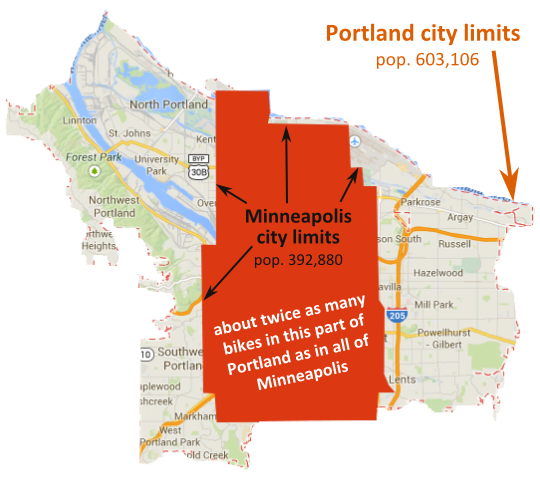
The Twin Cities metro area has about 50 percent more residents than the Portland metro area — it’s about the population of greater Seattle. But at 55 square miles, its central city, Minneapolis, happens to be one of the smallest major cities in the country. (Another often-cited city, Washington DC, is 61 square miles; Seattle is 84, Portland is 133, Chicago and Tucson are both 227 and New York is 305.)
This isn’t a bad thing, and it probably helps elect pro-bike politicians. (When incoming Mayor Betsy Hodges used her first proclamation in office to call Portlanders “wimpy,” I wondered if Charlie Hales was going to take it lying down. He did.) But it’s a perfect example of why Census-based city rankings are mostly matters of municipal coincidence. If Portland’s city limits suddenly shrunk to the size of Minneapolis, our bike commute rate would leap to a whopping 9 percent.
If you want a slightly better apples-to-apples comparison, compare the entire Portland metro area’s bike commuting rate (2.2 percent) to the Twin Cities metro area’s (1 percent).
That said, bikes are a huge part of Minneapolis culture. So why do its statistics lag Portland’s? Here’s part of the issue…
There are freeways freakin’ everywhere.
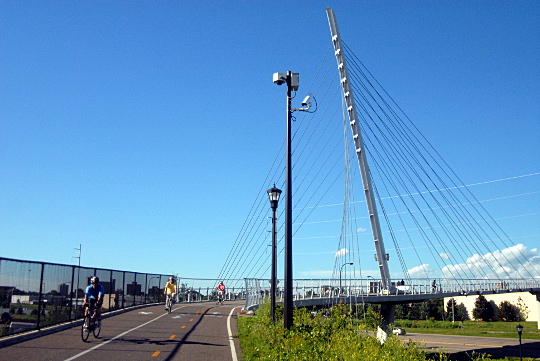
Above is the majestic seven-year-old cable-stayed bike-ped bridge that connects the Midtown Greenway to the new Hiawatha path into downtown. It’s a beautiful piece of federally funded engineering that deserves its iconic status in the city.
And here’s why it had to be built:
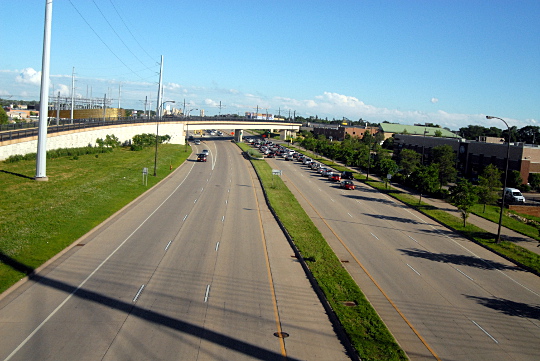
That’s Hiawatha Avenue, a six-lane stroad that chops through Minneapolis between downtown and Minnehaha Park. Fifteen years ago, a Hiawatha Avenue expansion project gave rise to the Minnehaha Free State, a beautiful but unsuccessful anti-highway protest; today this is just one of the ridiculous number of expressways that slice the city’s street grid to bits. Minneapolis has spent a lot of money repairing itself with bridges like the one above. But there’s only so much you can do.
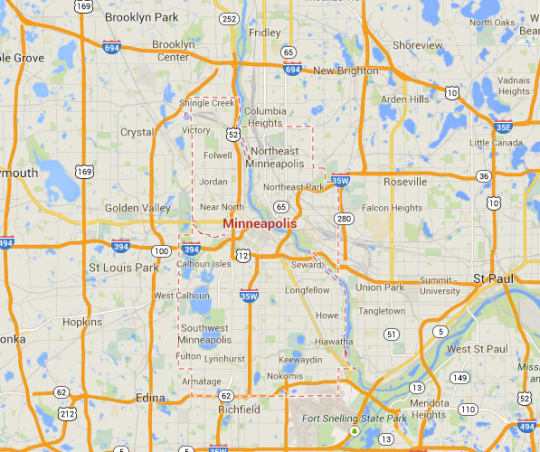
Portlanders congratulate ourselves more than we deserve for having killed the proposed Mount Hood Freeway through Southeast Portland in the early 1970s. At the time, more or less the same thing was happening in almost every major U.S. city, including Minneapolis.
But here’s a fact: today, the Twin Cities metro area has 50 percent more lane-miles of freeway per capita than Portland’s and 39 percent more lane-miles of arterial street. Well after the cheapskates and elitists of Portland started saying “no” to roadway widenings, Minneapolis’s idealistic Lutherans kept on saying “sure!” They created a region that remains deeply auto-dependent.
The Midtown Greenway is amazing, but a path is not a substitute for a street.
Minneapolis should be proud of the Midtown Greenway. The entire country should be proud of the Midtown Greenway.
It’s the most impressive urban rail-to-trail project I’ve seen, connecting commercial, industrial and residential neighborhoods in a straight shot through a sunken, forested railroad bed across the near south side of the city. Its effect on bicycle commuting patterns is practically visible from space.
This is what people look like when they are riding on the Greenway:
But here is the fundamental problem with the Midtown Greenway: the only storefront that seems to face it is a bike shop. In this case, a closed bike shop.
Off-street paths are wonderful parts of a bike network, and this one blows our Springwater Corridor away on width, location and connectivity. But if I were choosing a commute, I’d take the neighborhood greenways on Ankeny, Holman or Michigan over the Midtown any day. When I ride, I want to enjoy the full culture of my city: houses, cafes, cats. The Midtown Greenway’s links to neighborhoods are numerous and well-marked. But during my third trip on the path, cruising blindly through a city I was supposed to be exploring, I realized what all the curving exit ramps reminded me of.
I was on a tiny freeway.
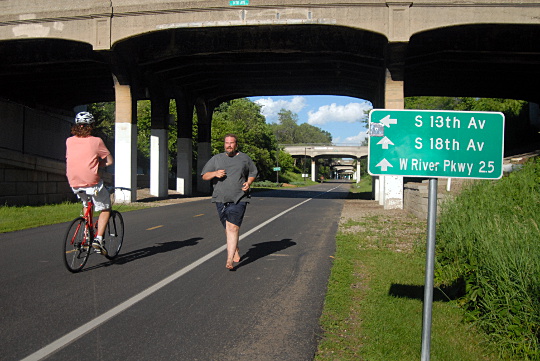
Another limitation of paths: safety. One rule of thumb for avoiding urban crime is to always be in eyeshot and/or earshot of at least two strangers. Most city streets would pass that test at 10 p.m. on a Saturday night in June. The Greenway didn’t.
I’ll say it again: this off-road path is terrific and I’d be in heaven if Portland had something like it. But off-road paths can’t do everything.
Advertisement
The bike lanes are pretty good. Sometimes.
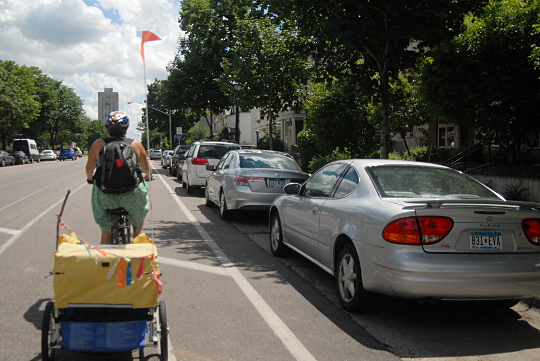
The best bike lanes in Minneapolis are as good or better than the best in Portland. The above shot is from Portland Avenue South, the auspiciously named local equivalent of North Williams Avenue. I love the double-barreled buffers, clearly separating bikes from both parked and moving cars.
Unfortunately, here’s the same important bicycle route a few blocks north.
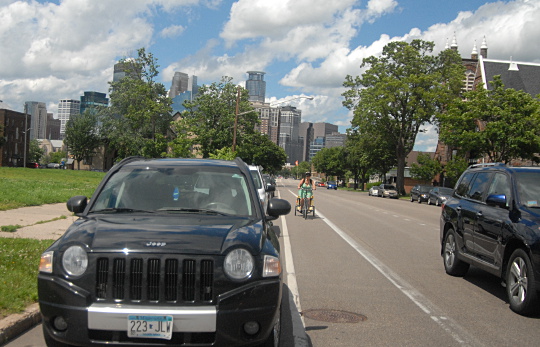
Here’s a nice use of a contraflow bike lane for a one-block connection…
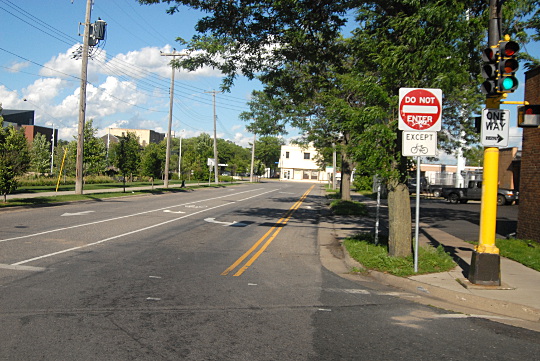
…and here’s a street that generously invites bicycles into the gutter.
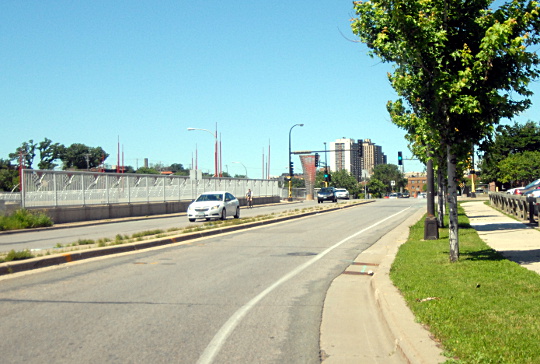
Here’s a major downtown street that, like many of them here, offers a conventional bike lane…
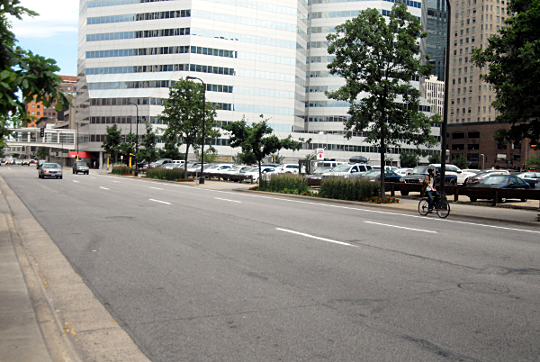
…and here’s a vast speed-bait expanse on the northwest side of downtown that didn’t exactly seem to be living up to the potential of the most valuable real estate in the Upper Midwest.
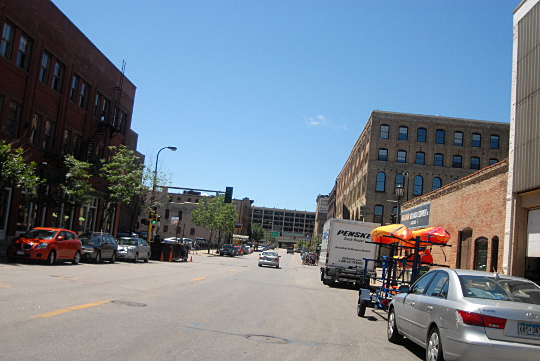
Unfortunately, one reason Minneapolis has been able to carve out a lot of room for nice bike lanes is also probably its biggest obstacle to further bike-friendliness. Compared to Portland, its roads are big and its auto lanes are wide. All that pavement invites speeding, slows walking and, despite many wonderful exceptions, deadens street life.
The waterfront paths are, OK, fantastic.
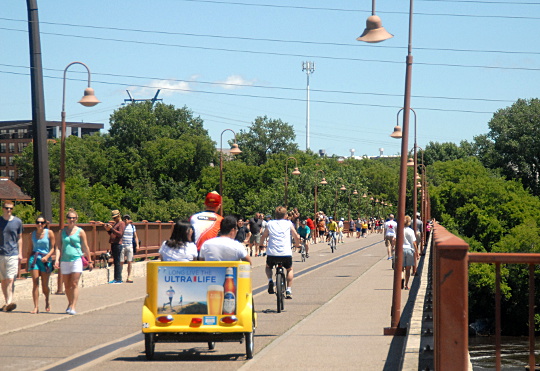
We didn’t get a chance to ride over many of the city’s bridges, though I’m told they’re impressive. But here’s a look at one: the wonderful Stone Arch Bridge, built as a railroad crossing but now a car-free link between the waterfront parks on each side of the Mississippi. Also, I wondered whether or not the folks at Portland Pedicabs have ever put in for a Michelob Ultra contract.
The bike parking could use some work.
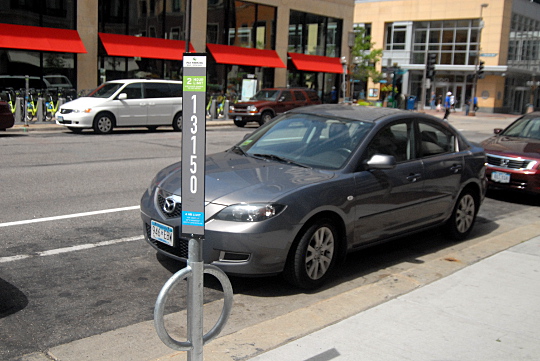
If any city on the continent can match Portland’s bike parking, I haven’t seen it yet. One nice touch in Minneapolis is that some of the auto parking signs double as bike parking. But on a busy Sunday downtown, those weren’t enough to stave off the great American tradition of locking one’s bicycle to any pillar available.
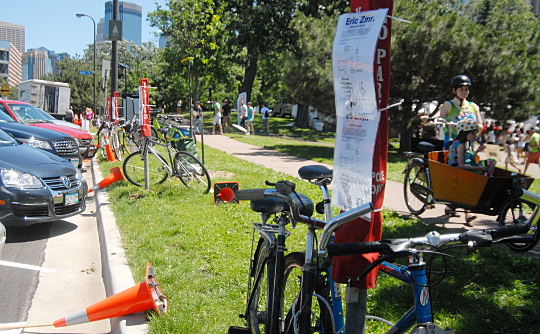
A good bike city, not yet a great one
There are lots of details I haven’t mentioned. For example, one of the country’s best bike-share systems, which plenty of locals were using and seemed to have a station everywhere we wanted to stop. Or the out-of-town bike connections, which I know nothing about but which it’s hard to imagine can compare to the Columbia Gorge or Pacific coast. Or the fact that in a more ethnically diverse city than Portland, the people using bikes seemed much more diverse, too.
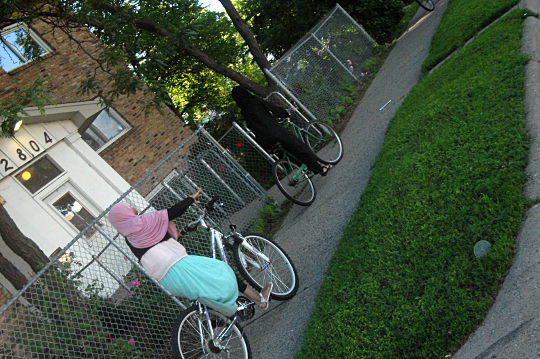
Four years ago, Bicycling Magazine did both Portland and Minneapolis a big favor when it flipped Minneapolis to the top of its “best bicycling cities” rankings, before reversing the order again in 2012. (I think every single Minneapolitan who learned we were from Portland, bicycle user or otherwise, brought up that ranking.) The magazine’s next two-year update of that list is suspiciously overdue, but I hope it’s on the way, because it’ll give everybody something new to talk about.
And I hope that, once again, it’ll use dubious logic to claim that some new American city has become the best place to ride a bicycle. There isn’t a city in the world that knows all the secrets. Let’s all look forward to our next excuse to learn somebody else’s.
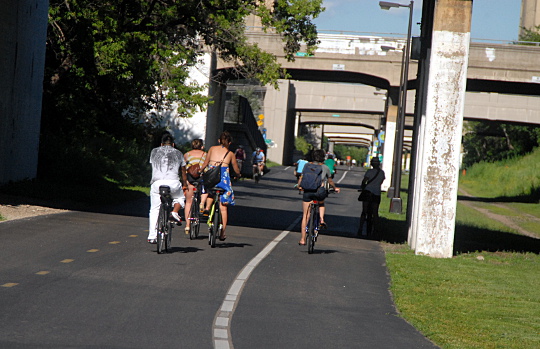


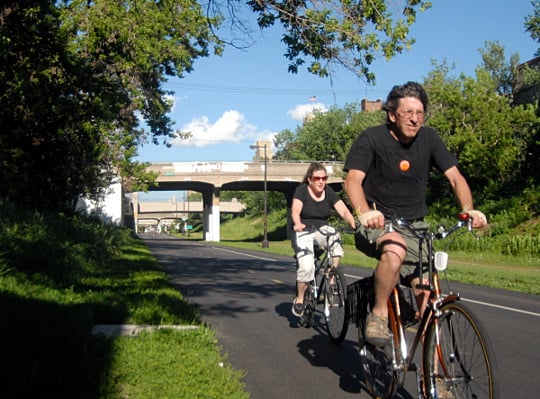
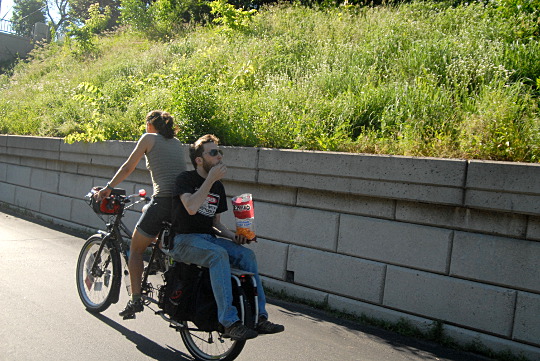
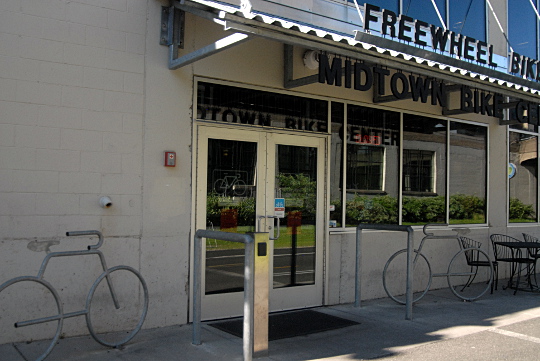
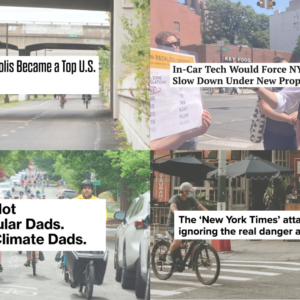

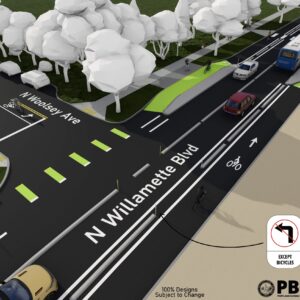
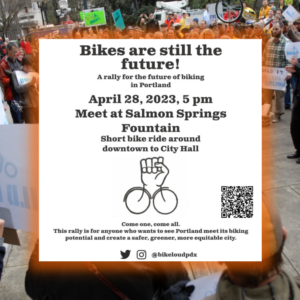
Thanks for reading.
BikePortland has served this community with independent community journalism since 2005. We rely on subscriptions from readers like you to survive. Your financial support is vital in keeping this valuable resource alive and well.
Please subscribe today to strengthen and expand our work.
I wonder if anyone has ever thought of rezoning land along a rail to trail conversion to allow offices or commercial businesses to be built. I bet businesses who don’t rely on a lot of auto traffic would like to locate on such a trail.
The land that the Midtown Greenway occupies is still owned by the railroad authority and is slated for a transit corridor that will significantly impact the bike path. http://www.metrotransit.org/midtown-corridor
That’s not true. Yes, it may get a street car line, but it won’t significantly impact the bike path. If you’ve never been on the Greenway, please don’t talk about it. Half of the width of it is unused green space that would easily accommodate street cars.
Actually I live in Minneapolis and no cross sections have been provided for the narrow sections east of Chicago Ave.
Too many issues. Ownership of the adjacent land? Electricity, water, sewer, telco infrastructure? Delivery of supplies, garbage pickup, construction vehicle access? Fire/emergency vehicle access? I can’t think of many businesses that is niche enough that they don’t need any customers to come by car, is small enough that they can haul supplies in and trash out by bike, yet is profitable enough to pay for miles of utility lines to be laid and their building to be transported in.
Or we could just revert to calling ourselves the number one bike city whether we are or aren’t. Now if only we could get people to stop using those blinky lights!
I moved to Portland from Minneapolis 8+ years ago and one of the small handful of things I miss about Mpls is the Midtown Greenway. That sucker *is* a bicycle freeway. (Street paths in the surrounding neighborhoods kinda blew at the time anyway, so it was that much better when it opened.)
Even without a crosstown bike-and-ped freeway, It’s still loads easier to get around Portland by bike. Plus, winter. And mosquitoes.
Nice write up of places to check out. I’m going to be there for my first time for four days at the end of next week.
Just South of where the Free State was, you can visit a special spring, Coldwater. Bike through Minnehaha Park, of course stopping to see the falls and the historic Depot (which stands next to a highway sound barrier now :/ ) at the absolute southern tip of the park (54th St) follow the “parking meter road” to it’s very end. Up the driveway you have two choices, to the right is to the Fort Snelling state trail and a beautiful ride. To the left enters the Coldwater Spring area. Lock your bikes in the parking lot or walk them to the spring. The spring pool is 42F degrees year round so re-consider that swim! This is the birthplace of the twin cities, where the soldiers were healed before they built Fort Snelling and where their water was piped from for many years.
The freestate was about many things, not just stopping a highway re-build. The spring was a key motivator. And it is sad to say that the new interchange next to the spring pollutes the aquifer on the regular. Dye tests have proven this.
Enjoy your stay in Minneapolis.
“Its effect on bicycle commuting patterns is practically visible from space” – but apparently not visible from bikeportland.org, or at least, not without context.
Michael, what the heck *is* that? I mean, obviously it’s a map of MSP census tracts, but what does it mean? Where is the path? Most of us have never been to MSP except for its airport, so a path location and/or additional context for the linked image would be helpful and appreciated.
Ha! Good point, Matt. It’s the dark east-west line across the central south side of the city. I’ll add a link to this map of the path.
http://www.mccyclomaniacs.us/maps/2011/110701_stone_arch_bridge.jpg
R.I..P. Jim Oberstar 🙁
As someone who grew up in Minneapolis and now lives in Portland, this article shows an unbelievably shallow understanding of the Twin Cities. First off:
1 – It’s called the Twin Cities because there’s another city right next door that’s effectively part of the same metro. Comparing Minneapolis by itself to Portland is useless, since the barriers between the two are negligible; the relationship between Minneapolis and Saint Paul is analogous to the east and west sides of Portland. Saint Paul isn’t a suburb like Gresham or Beaverton, it’s an integral part of the Twin Cities, and combined the two have a larger population than Portland. Slightly smaller area, but the distinction between Minneapolis and its first-tier suburbs is much less than Portland its suburbs, so I’d actually roll Richfield and Bloomington into the area as well; maybe Edina and St. Louis Park if I was feeling generous.
2 – Portlanders are wimpy. Sorry if that offends people, but I was there when you had your most recent “snowstorm”, and the whole city was shut down. I live on Ankeny, and while it’s a fantastic route most of the time it becomes a ghost town when it rains, at least after the morning commute is done. Contrast that with Minneapolis, where it’s downright embarrassing to call yourself a bike commuter if you don’t own a fatbike for the winter. I came back to visit family, and the streets were full of bikes even as a severe thunderstorm warning was active for the entire county, in Minneapolis you don’t go inside until the tornado sirens go off.
3 – The Midtown Greenway is, by far, the most enjoyable urban biking experience I’ve ever ridden, and there’s simply nothing in Portland that compares to it. Call it a bike freeway if you want, that’s exactly what it is, but it simultaneously manages to be the most effective way to get from A to B on a bike and incredibly safe for cyclists of all levels. Bike Boulevards like Ankeny are a smart way of reconfiguring city streets to support bike traffic, but I spend much more time negotiating 2-way stops, jumping speed bumps, dodging pedestrian traffic, crossing busy streets with no right of way, and even getting stuck in car traffic when someone turns onto Ankeny to find a parking spot. The percentage of time I spend on Ankeny visiting “houses, cafes, and cats” is pretty minimal, I’m more focused on not getting t-boned and swerving around new cyclists who think Ankeny is a one-way going whatever direction they are.
4 – Minneapolis has better segregated facilities than Portland hands-down. It’s partially due to historical reasons and partially due to geography (there’s a lot of lakes and riverfront that is owned by the city as parkland) but for recreational riding it’s completely unmatched. I don’t think Portland has a single path that’s marked exclusively for cycling (correct me if I’m wrong please, I’d love to ride it) while shared use paths are rare enough in Minneapolis parkland that they require a special sign to warn people. You can circle all the lakes on wide, smooth paths and never have to dodge around 4 pedestrians walking abreast, unlike the Springwater Corridor. The creek also has a dedicated cycle path running most of the width of the city, and the river has TWO cycle paths going north-south, one on either side. In the winter, they even get plowed!
5 – I toured from Portland to Minneapolis, and while I can’t speak to every direction I can say that the route out of Portland to the east was miserable, compared to the route into Minneapolis from the west. Crossing through East Portland is a great way to get right-hooked or even hit from behind by an angry truck driver. In contrast, the Twin Cities metro has regional trails that start 60 miles out of the suburbs, and connect to the city trail system, with maps at all the junctions.
Portland does do a better job with Bike Boulevards though, and as far as biking for transportation is concerned I would say that SE has a bigger swath of contiguous bikeable area than anything in Minneapolis, due to high-traffic roads chopping up residential streets.
Are (or perhaps now that you live here, “were”) you a mountain biker? I have heard that the mtb riding in/near the Twin Cities is FAR superior to anything we have here.
Naw, I I lean toward skinny tires and drop bars.
You’ll also find that Minneapolis has singletrack trails in the city for mountain biking, which for the exception of the newly build dirt walkways at Powell Butte and 3/4 of a mile of trail in Forest Park, Portland cannot.
Theodore Wirth park was a pleasure to ride and I got there easily from my hotel in downtown Minneapolis. It sure beat putting my bike in my truck and driving 45 minutes to the nearest decent trail from Portland.
If you come back to Minneapolis – check out Theo Wirth again – we just added 2 more miles of super fast trail! It’s get some gnarly berms and a couple drops. Tons of fun.
Great thoughts, Daniel! I definitely agree that my understanding is shallow.
On the Census stuff, including St. Paul as part of the “major city” here wouldn’t strengthen the case for the Twin Cities as better for biking; the mode share there is only 1.5%, for a combined bike share of about 3.3%. So, again, about half of the mode share of a comparably central swath of the Portland metro area.
Oh definitely, I’m not saying that Saint Paul’s mode share numbers improve the area’s average, just that it’s not fair to represent Minneapolis/Saint Paul as a “small” major city. It’s got all the same challenges as Portland, unlike a place like Davis, California. Portland has Minneapolis beat on bike commuter percentages, but I’d chalk that up to a combination of a challenging climate and a political environment that’s steered much more toward biking for recreation rather than transportation. The size of the two cities is relatively even ground.
As someone who grew up in Montana and spent a little time in St. Paul going to college, I agree that St. Paul is its own city in itself and not a suburb.
But, as far as cold weather and being wimps, I think you are missing the point. While Montana is not as cold and it gets less snow that the Twin Cities, I am just going to use it as a more appropriate comparison. When I was living in MT, I had a heavy jacket, heavy ski gloves, and a bike that had knobby tires. Although I was not a bike commuter, I would have planned on getting a fatbike with studded tires if I did.
In Portland, I find no need for those things above. The snow storm we got in February was the first really measurable snow the valley floor received in 5 years. In MT and MN, motorists are used to driving in the snow and ice (a quick search on YouTube will reveal how well Portanders can handle it), so that creates an additional danger to people riding bicycles.
And, sure, as the rain starts to fall, you see less bikes. Doesn’t the same thing happen when the snow and ice hits the Twin Cities?
I think the difference is that when you’re dealing with bike boulevards, less bikes quickly becomes more dangerous. Even if nobody else wants to ride the Midtown Greenway in -10F I can still ride it myself and the risk of injury isn’t all that much more, while the last time I biked on Ankeny in the rain I was almost hit by a car twice in between Sandy and 24th.
What?
“jumping speed bumps”
you are supposed to slow down and roll over them. though i guess they are good bunny hopping practice…
“embarrassing to call yourself a bike commuter if you don’t own a fatbike for the winter”
oh please. i was a year round every day cyclist in chicago and southern indiana prior to moving to seattle in 1990. i even biked during the blizzard of ’78 on a crappy schwinn (pure fun). few cyclists in msp own genuine fat bikes. in fact, very few cyclists anywhere own fat bikes.
in msp and chicago snow is rapidly efficiently removed and roads are de-iced. this is simply not the case in pdx. in fact,during the last so-called pdx snowpocalypse i cycled up and down pill hill every day without fail (i commute to work 7 days a week). in fact, the thick layer of hard snow covering sheet ice was marvelousl (oh f*ck!) technical and the kind of mtbing that is never seen in the urban core in msp (ever).
That’s funny, because my MSP friends who are serious cyclists just can’t stop talking about their fatbikes, and I’ve seen the photos on Facebook to prove it. Snow on ice is pretty standard for a Minneapolis winter too, routes that are designated as snow emergency will get plowed regularly, but sidestreets tend to build up enough snowpack that they usually have a smooth layer of ice beneath any recent snowfall. Trust me, I’ve gotten my car stuck in it many times.
What’s really crazy is when you have a big pile of fresh snow that gets rained on and then re-freezes, so there’s a hard layer of ice that will support you just long enough for you to move all your weight over it before it cracks and drops you into a few feet of snowbank. Happens every year in Minneapolis, as kids we used to wander out onto the boulevard and see how many steps we could take before getting dunked.
serious cyclists are a minority. and serious cyclists with fat bike are a minority of a minority.
Cyclists in general are a minority. You really seem to dislike fat bikes.
They’re certainly ubiquitous. But only in the last 2-3 years. I bought one for the first time last winter just because it was *so* evil. They actually removed half of ALL parking in the city because otherwise emergency vehicles couldn’t get through.
A fat bike made it actually fun, but I could still ride just fine with 35c studded tires most places. For about 4 or 5 years I just did a fixed gear with platforms and cross tires, cobbled together out of beater parts because the elements would kill things by spring.
So, yeah, fat bikes are really just for kind of privileged cyclists that can afford two bikes, and spend over 800 for a bike that probably only gets ridden in the winter. But I know a lot of people that ride the same bike year round…
“Contrast that with Minneapolis, where it’s downright embarrassing to call yourself a bike commuter if you don’t own a fatbike for the winter.”
Maybe that’s an additional reason for the relatively low commuter rate – the cost of owning two bikes (and it would seem fatbikes aren’t cheap) makes it prohibitive for most to commute all year. In PDX I just need one cheap one.
“Maybe that’s an additional reason for the relatively low commuter rate – the cost of owning two bikes (and it would seem fatbikes aren’t cheap) makes it prohibitive for most to commute all year. In PDX I just need one cheap one.” Whoa, that’s taking the “embarrassing” comment way too far. Fatbikes have only been available for a few years, and only really popular for a couple of years, but people have been winter commuting in Minneapolis for way lot longer than that. Studded tires are awfully nice to have, but you don’t need a second bike unless your first bike is one of those 23c-max racing machines.
Great article, Michael, with much to consider, indeed! You’re right that the two cities are very different animals, and each has big advantages over the other (lack of sub-zero winters scoring hugely in our favor LOL).
John: be SURE to bike on the famous Grand Rounds paths that lead around several stunning urban lakes, gorgeous Minnehaha Falls, the incredibly bike- and recreation-focused riverfront, and more; you will be in absolute heaven (http://www.minneapolisparks.org/grandrounds/home.htm).
And unlike the Midtown Greenway (which is a superb, incredibly rapid commuter route for many folks–and with zero intersections to contend with), the Grand Rounds bike paths within Mpls city limits are all in urban neighborhoods that are up there in beauty and charm with just about anywhere in this country–and you’re never more than a mile from a lake or a river throughout the entire 55 miles (and along totally safe bike paths meandering through beautiful parkways). The bike trail network throughout the Twin Cities (and going out well beyond the metro area in every direction) is so impressive that it makes me depressed how far behind we are in this regard.
We are still in our very infancy in Portland regarding providing cycling infrastructure and connectivity that would appeal to all levels and ages of people getting around by bike. I just wrote LONG letters to both Leah Treat and PSU President Wim Wiewel about taking advantage of the momentum we might have regarding cycling connections from dozens of awful ramps to the riverfront, Old Town and PSU.
You can be sure that Minneapolis (and St Paul and countless trail-connected suburbs, lakes and small towns) will continue to make massive progress in its cycling infrastructure. Like Michael said, it’s probably best if another city wins the “best bicycling city” award. We need all the motivation possible to get our bicycle mode share well into double digits.
Great article – I learned a lot about both cities.
You kind of put down the Greenway as a “tiny freeway,” but as far as transportation goes, people like to drive on freeways and bike on tiny freeways. Biking around a city, you may “want to enjoy the full culture of my city: houses, cafes, cats,” but I guarantee you most people biking from A to B would like to be on something that feels as a safe as a “tiny freeway,” built just for bikes.
Amen! I commute and, like car drivers, I want to get from point A to point B swiftly and efficiently. When I have to be at the office by 8 AM, I could not care less about how pretty the trees are, admire Mrs. Rosenbaum’s flowerbeds, or rate how attractive line of people at the new fair trade coffee house is. I get quite irked when BikePortland keeps trumpeting that the only correct way to ride in this town is at less than 8 mph lest we offend or frighten the “interested but concerned”.
I wish that we had something akin to the MPLS Greenway to and from places like Beaverton, Tigard, Gresham, etc. Want to improve pollution and gridlock in our REGION? Make it easier, faster, and safer for suburbanites and those living beyond the 40s to get in and out of town by bike. So tired of the mentality on this site, “Don’t already live in a cool close-in ‘hood? Sucks to be you! Get a better job so you can buy that $600K fixer bungalow and move outta’ B-Tron. More stuff for us! Screw you Lents, Gateway, Milwaukie, Multnomah Village, and the like!”
I do find it irksome that the best route from Hillsboro/North Beaverton to downtown is US 26—straight, easiest grade, no stops, and presumably only for cars. I admit I use the last little bit of it to finish my trip into town, but even that requires me to exit early and go north out of my way to Goose Hollow, when I really need to stay south. For those that don’t like using the shoulder of a freeway, the options are either climbing or more climbing, and you can pick between twisty or twistier to get over the last bit of hill and then down into town. Even going out of my way, I spend 5 minutes less taking the freeway for one exit instead of more climbing and winding. I have a greater-than-ten-mile commute, which grows even more going out of town because the options are fewer for uphill routes out of town that aren’t filled with blind corners and heavy traffic, and I refuse to exert uphill effort on the fume-filled smoggy afternoon shoulder of 26. I spend an hour in and an hour+ out, when I could likely do each way in 50 minutes or less if I could take the three-miles-shorter-and-easier-grade route I get to drive.
I wish the default for designating bike routes was something other than byzantine zig-zags and/or narrow MUPs. The assumption that cyclists are a) unemployed goof-offs out to waste a leisurely day putzing around coffee shops and brew pubs, b) cat-2 racers out for a speedy training ride on rural roads, or c) Couch potatoes out for one of two yearly obligatory rides with the kids on trails, needs to be put to rest.
While I wouldn’t be too harsh on those wanting to cater to the “interested but concerned”, I hate to think that the efficiency (yes, that translates loosely to “speed”) of my commute trips would be sacrificed in the process. The last thing someone who is already stretching their schedule to bike commute needs is to be forced into a cattle-chute-like “protected” bikeway with 8 and 80-year-olds. If we want to find out what kind of bike infrastructure “works”, let’s make using it optional—lookin’ at YOU 814.420—and watch who chooses what. Unfortunately, the so-called “powers that be” seem to believe that cyclists will choose any illusion of “safety” over faster travel every time: “As long as we tell them it’s ‘protected’, they won’t care how slow or out-of-the-way it is. Besides, in Oregon there is no choice anyway….BWAhhh-ha-ha-hahh!”
Double Amen!! When I’m commuting, I want to get to work and then get home, and while scenery is nice it isn’t something I’m focused on. I’m focused on the glass and debris I need to avoid, and watching my mirrors so I can best fit into the car traffic to do so.
What we need is CONNECTIVITY. It’s no good having a great bike lane on this road, but nothing on either end. It’s also no good to have an orphan bike lane in the middle of a road because a new development went in– I’m not going to ride in it for a block and then try to get back out into the traffic lane.
CONNECT Beaverton, Tigard, Tualatin, Sherwood, Wilsonville, Lake O, West Linn. Make it easier for those of us to get around on 2 wheels, we won’t be helping clog up the streets during rush hour.
Like Daniel, I grew up in the Twin Cities, but have lived in Portland for nearly 20 years. I would agree that Portland’s core is better for bike commuting than Minneapolis’ core – yes, hands down – BUT! That ignores some very important points in the Twin Cities’ favor.
Portland’s infrastructure drops off to crap pretty fast once you leave the core. East Portland has the advantage of bike lanes and MN-quality flatness, but last month we all talked about how bad that infrastructure is. And Portland gets worse when you go the opposite direction, over the West Hills — which I have to ride over Every Damn Day. Bike options are extremely limited for getting over the hills without dangerous connections and/or massive climbs. I would trade my evening ride from Beaverton to Southeast Portland for a 12-mile ride from Eden Prairie or Golden Valley to South Minneapolis, in a heartbeat.
Why? For one thing, as Daniel mentioned the Twin Cities have a massive network of off-street paths – long distance ones that actually GO SOMEWHERE and are useful for bike commuting. Both in the city, but also extending way out towards exurbia. I grew up in suburbia, thinking it was normal to have bike paths everywhere. Also, MSP suburban feeder roads are more likely to have shoulders (in part because of snow removal needs) and sidewalks, rather than being a skinny paved cowpath as is true in many Portland suburbs. And finally, in my experience through-neighborhood connectivity on the side streets tends not to be as bad in Minnesota suburbs than in Oregon suburbs. All in all, with the exception of Beaverton (which is exemplary), I find it easier to get around MSP suburbs than PDX suburbs.
The Bike Freeway (Midtown Greenway) is unique, but portraying its downsides (offramps, crime) as somehow indicative of MSP riding conditions is completely absurd – precisely because it is so unique, even among the hundreds of miles of MUPs within the Twin Cities. It is, however, an important discussion to have because (1) we’re contemplating a Bike Freeway ourselves through Sullivan’s Gulch, which may potentially have many of the same problems, and (2) some of our own semi-freewayish MUPs (Springwater) already have some problems with crime and/or cyclist-homeless conflicts.
Also, bike friendliness isn’t just about commuting. I like to ride my bike on dirt trails in the woods, and in Portland that means strapping it on top of a car and driving an hour or two, thanks to the all-powerful hiking lobby. In Minneapolis, I have 10-12 mountain bike trail systems to choose from within the metro area, many of them reasonably reachable from the city via bike. Also, thanks to fatbikes you can have as much fun as MTBing by just riding on the snow almost anywhere in the Twin Cities’ vast park system plus about 200 frozen lakes scattered across the metro.
Summary: If you’re one of the lucky few who lives AND works in the urban core, then Portland is unquestionably more bike friendly (and I do mean lucky – Portland’s downtown job base is pretty small compared to the MASSIVE one in downtown Minneapolis). Also, if you can’t handle severe weather (weekly thunderstorms, stronger average winds than Chicago, occasional tornado warnings, hot summers with wicked humidity, voracious mosquitoes, snowstorms, brutally cold temperatures and wind chills) then Portland is probably the better city for you.
If, however, you need to commute to or from the suburbs, or you like to mountain bike, or you like long recreational rides on car-free paths, or you like four seasons of real weather, or you roll your eyes at people who whine about BB-sized gravel on the roads in February, then Minneapolis isn’t so bad. Hell, maybe I should pack up the family and move back there. It’s bike friendly enough, housing is way cheaper and incomes are higher. Hmm.
Thanks for sharing this. I am still hopeful that eventually Portland Parks will see the myriad reasons to establish Portland as a fun place to also own a mountain bike. I am getting tired of having to drive my car to ride quality trails. It doesn’t make sense considering how much space we have within the metro region. What will it take?
Yet, for the one-two hour drive you get a pretty solid bang for your emissions. Sandy Ridge as given me mixed feelings about dicing-up Forest Park with single track beyond the fire lanes. All the fat tires, going one, two, three hours in all directions around the PNW is better than all the fat tires going 10, 20, 30 mins to the same destination. I cautiously think.
As someone who rides Sandy religiously, I have to disagree. We need both. We need super high quality riding at Sandy Ridge, and we need options in town for the post-work ride, ride with the kids, etc. I don’t expect any area in Portland to EVER look like Sandy Ridge, but having something worth riding in the city (in multiple areas, for different types of riders) is sorely needed.
I average Sandy once a week year round; usually on the weekdays after work in the spring/summer/fall. There’s probably a complicated equation for incorporating Sandy traffic and Cross Crusade crowds into what will always be too many people on too few trails build in Portland. It’s not to say we don’t need it. Of course we need (and want) mtb trails. But how? How do we manage the traffic? Not a conversation for this page. Just pointing out, we have some amazing places to ride all kinds of bikes, but I haven’t seen how we can truly have it all in the realm of fat tires.
Glowboy,
Any ideas for ways to make progress in the mountain bike advocacy movement?
Each of us should take out a $10k life insurance policy that pays out if we are killed in a traffic accident, with local advocacy groups named as the beneficiaries. MTB, transportation, USCF, BTA. Whatever you want to support….
Except for the fact they involve climbing a big hill, at least a couple routes from Portland, west to the suburbs, aren’t bad at all, in fact, their nice. In terms of capacity and interruption free travel, they wouldn’t be on a par with the ‘bike freeway’ MSP is described as having, but they’re quiet, in nice surroundings, and reasonably safe to ride.
It would though, be good to have something like the bike freeway, in places throughout the Portland Metro Area. Progress is slow. Take a look at any new development occurring in the metro area in the last, say 15 years, and consider whether there’s been even as much as a main road distanced cycle track proposed, planned and built. Nothing. Some progress here in that respect may be though, that more people may at least now have some idea of what terms such as ‘cycle track’ and ‘bike freeway’ actually refer to.
Sarcastic, naive remarks like ‘hiking lobby’, will never help to identify true reasons mountain biking does not get broad support for carving out more opportunities for that activity, somewhere within Portland city limits. If anything, sour grapes attitudes will probably distance even further from a broader base of support than the very narrow support for that type of riding that exists now.
I still think about environmental conservation minded people someday joining together in working to have the remaining, yet undeveloped segment of the south face of the Tualitan Mountains established as a southern expansion of Forest Park. Opportunities for mountain biking could be included in creating the expansion. Modest vision and desire, likely is why dramatic improvements to active recreation and transportation happen so slowly in the Portlnd Metro Area.
wsbob — you wrote
“Except for the fact they involve climbing a big hill, at least a couple routes from Portland, west to the suburbs, aren’t bad at all, in fact, their nice”
I’m wondering which routes you’re thinking of.
Thanks,
Ted Buehler
The only routes out of town toward the West that I ever take have some “nice” sections: one is “Hewett Blvd”, one is called “Terwilliger Blvd”, and the third is named “Fairmount Blvd”. However, the other sections of these routes are fairly crappy (Beaverton-Hillsdale Hwy, uphill on Patton Rd., US 26 MUP [nice that it’s separated, but has other issues, e.g., jointed concrete, dangerous connection at Sylvan], Cornell Rd. between Murray and Science Park…). Plus, regardless of how “nice” any of my routes may be, they are all two to four miles longer than those I would take in my car, so automatically take 8 to 20 minutes longer than if I could ride my driving route.
OK bob, what do you think are the “true reasons” MTBing doesn’t get the kind of broad support that it gets in – oh, I don’t know … the entire rest of the United States? I think there are two main reasons.
1. The hiking lobby. Using that term isn’t not sour grapes; it’s refreshing honesty, when there’s so little popular awareness of how these groups have truly been functioning. The hiking groups are the ones behaving oppositionally, but I’m the bad guy for daring to call it out?
At first the hiking groups’ environmental mission dovetailed with their role as advocates for hiking interests. That was great and they accomplished a ton. But that also meant a lot of fuzzy-headedness about the difference between those two roles, once they largely won the Timber Wars and got their hiking territory protected from development. Their diatribes against mountain biking often tinged with righteous environmental outrage, which is ridiculous bullcrap. When they behave this way they are behaving as a user advocacy group, which is fine, but they do it waving the Environmental Organization flag.
If the hiking lobby doesn’t want to share, they should at least be honest about the role they’re planing, and cut the rhetoric about how non-motorized bicycles destroy trails and scare wildlife. A few years ago, when the Wyden Wilderness bill was under consideration, the Oregonian published a letter actually criticizing mountain bikers for driving to trailheads in gas-guzzling SUVs and using unsustainable expensive ultralight equipment. Sheesh, ever look at the parking lot or the backpacking departments at an REI? Pot? Kettle?
2. Nonchalance from the Portland (and Seattle) “biking communities”, which IMO are so focused on utilitarian cycling that recreational cycling (especially off-road) is too often ignored or even disparaged. That doesn’t happen as much in other large cities, and is a big part of why Portland’s Platinum status is questionable.
There is no ‘hiking lobby’. That’s some descriptive phrase you and maybe others have dreamed up and apparently like to use to try shift blame on environmentalist and conservation minded people for the failure of mountain bike enthusiasts to convincingly make a case for using wilderness and nature parks for vehicular recreation, which is what mountain biking is.
Because I’ve got to head out shortly, I don’t right now, have time to detail reasons why I feel mountain biking doesn’t get the support in the Portland Metro area or Oregon in general, that it does in some places across the U.S. . Though in fact, in years past, to bikeportland stories, as many bikeportland readers well know, I’ve commented at length about those reasons. I probably won’t go over that territory here as I have previously. Amongst bikeportland’s readers that post comments and that favor mountain biking, most apparently are disinclined to self reflection in terms of why their efforts to have sensitive areas be used for their choice of personal recreation does not seem to garner much support.
Buehler and others about good routes over the west hills: as others mentioned, Humphrey and Huett are very nice, but starting out lower, through Washington Park. Vista is ok too, and nice, but the grade really is a grind. Once over the hill, the Sunset MUP (I’ve just ridden the south side.) works well.
The seams are not a big deal if people don’t put so much of their weight on the saddle. Watch out for downhill speeders on the MUP. My preferred street route down the hill is Canyon Ln just south of 26. Raab road past the DOT center and the church. Canyon Ln meets up down the hill with Canyon Rd where auto row is, a bummer for me, but only bad up to Walker. All for now, I’ve got to get outa here.
We’ve made the case over and over again – and it’s pretty clear that bicycling was in fact presumed to be acceptable in the original language of the Wilderness Act, same as other forms of vehicular nonmotorized recreation like canoeing and backcountry skiing – but the hiking clubs fought us tooth and nail. I think that’s because hiking is more likely to conflict with hiking than the other modes.
I’ll stop calling them the Hiking Lobby when they work with mountain bike clubs to promote clean, healthy non-motorized recreation across the board and stop treating bicyclists like ORVers. That doesn’t mean opening all wilderness trails to bikes, not by a long shot, but it does mean stop being adversaries. The adversarial nature of the relationship is all on them, not us.
Anyway, the point of this thread is not the merits of mountain biking (upon which your views are well known) but the relative merits of Portland and Minneapolis for various aspects of cycling. One of which (for many cyclists) is mountain biking. As I pointed out when I brought it up, Minneapolis has an advantage for people who like to mountain bike close to home. If you’re not into mountain biking, fine, then it’s not something you have to consider.
Environmental organizations have offered to work with mountain bike enthusiasts to develop mountain bike opportunity in forest lands and whatnot, outside of wilderness areas and nature parks. Mountain bike enthusiasts have rejected the offer. Bikeportland in past, has done stories about this.
Personally, and I think likely the same with many metro area residents, I have few if any qualms about the development of mountain biking opportunities within city limits, just not in nature parks. I wish there were a mountain bike single track between Central Beaverton, east, over the hill into Portland. If there were, I’d probably get a mountain bike and ride the trail regularly. We could beat Minneapolis hands down, if that’s the objective.
The reality seems to be, that people in the Metro area are just not that interested in mountain biking or in developing mountain bike opportunity near to or within urban areas, or in topping Minneapolis’s offering of mountain biking opportunities. If they were, they’d be barraging city hall and the newspapers and the county, with demands for mountain bike opportunity near their neighborhood.
If mountain biking opportunity within or close to cities and neighborhoods really were of much importance at all to people seeking to live in metro area cities and counties, you better believe housing development developers would be staying up late at night trying to figure out how to incorporate a great trail into their next development. Or siting their development close to a mountain bike park. Or, knocking on city hall and the county’s door, demanding that mountain biking opportunity be provided as an aid to selling more houses. Very few people ask, so very little happens.
I also have to concur with Daniel’s point #1 that the city-limits comparison is useless unless you include St. Paul. Half of the land within Portland would be part of a suburb if it were in the Twin Cities (and in fact, nearly half of today’s Portland was suburban until the 1980s land grab – er, annexation, of East Portland). But the point is true that cycling is much lower there than here if you take the entire metro area into account. MSP is still a massively more car-dependent place, in terms of both the excessive development of freeways and the staggering sprawl out into the countryside. And in Minneapolis you will NEVER, ever see a car stop for a pedestrian waiting at an implicit crosswalk.
I don’t agree that the reason Portland shuts down in snowstorms is entirely because Portlanders are wimpy. It’s that we only have a few dozen snowplows (compared with literally thousands in the Twin Cities) and much hillier terrain. Also, our snow tends to be greasier most of the time because it’s usually near freezing when it does snow here. The storm we had earlier this year where it was 18 degrees and we got a bunch of dry, grippy snow is exceedingly rare here.
Yeah, crosswalks really don’t mean a whole lot to drivers in Minneapolis. It actually kind of annoys me when a Portland driver will slam to a stop to let me cross a street while I’m waiting for a break in traffic (and I fear for any Portlander who moves out east and expects the same courtesy) but I suppose the lack of pedestrian deaths speaks for itself.
Maybe “wimpy” isn’t entirely fair, I’m just a little angry because I had plans to meet some friends at a bar that night, and after calling the bar first to confirm they were still open I walked over there and discovered they’d decided to close anyway because nobody else wanted to leave their houses.
In fairness to Minneapolis, yesterday I reminded myself that it’s not really better in the Portland metro, outside the core. Unless there’s a high-intensity beacon telling them to, good luck getting cars to stop for you anywhere between Burlingame and Hillsboro.
the ironic thing is that by bringing up sp you are actually strengthening michael’s argument. sp’s bike mode share is a ~2%. it’s basically beaverton when it comes to bike mode share.
in other words, meh.
My point isn’t that Saint Paul boosts modal share for the Twin Cities, it’s that the Twin Cities aren’t actually as small of a place as they’d appear if you only consider Minneapolis. That attitude tends to grate on you when you grow up in a place that’s referred to as part of the “fly-over” states. MSP may not win the battle for best bike city, but it’s definitely playing in the big leagues.
To be fair, it’s kind of hard to fly over Minnesota. I keep trying, but Delta always makes me stop there.
As a resident of the Great Nordland, this was interesting article. However, some more context will make this article bit more well rounded.
First, Minneapolis is late to the bike game compared to Portland. Its easy to point out that Portland is ahead of Minneapolis in a lot areas. However, as BikePortland itself has pointed out, Portland seems like its lost its mojo as regards to bike friendly access. Yet, Minneapolis is still charging ahead. If this continues, in 5 years the comparisons in this article will be tipping in Minneapolis’ favor.
Second, Minneapolis does have a lot interstates. This is true of a lot of cities. Especially midwestern ones. I don’t know if its fair to ding current efforts to improve bicycling in Minneapolis for the sins of a past generation.
Third, Minneapolis is filled with Greenways and paths that aren’t the Midtown Greenway. This includes the Ground Rounds. (As pointed out by a previous poster, its awesome.) This has more advantages than just transportation bicycling. Minneapolis parks and surrounding community parks have a lot of singletrack MTB trails and most of them are able to be accessed via the greenways and paths. Its possible to live in an apartment in down Minneapolis and bike your way to dirt in a few minutes.
Greenways might be like a highway. But just like a highway, its purpose to convey persons from one point to another as quick as possible. I wouldn’t get too worried that fact the Greenways don’t have at-grade shops and housing. There are some land ownership issues in doing that. If the author had gotten off the greenway, he would have seen that development is starting to get caught up to the greenway revolution. There are many amenities within a block of the greenways that are there now BECAUSE of the greenway.
Fourth, its a shame the author didn’t hit the longer paths out from the city center. He would have be shocked at how far you can go in any one direction without getting on a road. He could have ended up in places like Hutchinson, nearly 60 miles away. And its just not Minneapolis. I live in northern Minnesota (3hrs north of MSP) and I can bike out my garage and end up in a myriad of towns, some of which are 100 miles away from my house, all without touching a roadway. (Eventually, the path by my house will be linked to one coming northward from Minneapolis. Imagine that!)
Fifth, its easy to try to do Minneapolis vs. Portland comparisons. But at the end of day, both cities are in this together. We can learn from each other and help each other. Minneapolis has learned a lot from Portland. And now Portland could learn a lot from Minneapolis.
The focus of your article is on metro, which I suppose is fair enough. But as a suburban dweller here (Lake Oswego), and former suburbanite from the Twin Cities (Mahtomedi), I must say that I vastly preferred my relatively peaceful, 12 mile bike commute along wide streets in the MN ‘burbs to the annoying, stressful 3.5 mile mini-commute in LO. And the Gateway Trail gave me easy access to downtown St. Paul, whereas I have not yet found a peaceful way to get from LO into downtown Portland.
On the flip side, Mahtomedi was an auto wasteland, whereas I can walk or bike to lots of great things right in LO. And during last winter’s Epic Snowstorm (which wouldn’t have even made the news in MN), I had the roads to myself – no cars or bikes! So all in all, I do prefer Portland to Minneapolis. But let’s not get too nasty with the comparisons; both places need vast improvements, in the urban center and the suburban surround.
Imagine a city with both the “tiny freeways” paths AND our pretty great greenways.
That’s the city that will beat both of us. Don’t really know if it’s coming anywhere soon, but who knows.
That would be the oreo cookie I’d like to eat.
Imagine a Portland where I-84 is replaced by a public park, with a daylighted Sullivan’s Gulch and a bike path running through acting as that tiny freeway. Now THAT’s somewhere I want to live!
And apparently never leave (with even less highway options, than the minimal ones we already have).
Washington, D.C. is getting close to that sort of mix.
So you start an article claiming that Portland is better than Minneapolis for cycling, then write a long article that pretty much just proves that Minneapolis is the best city on Earth for urban cycling. Alright m8, you’re just jealous. Don’t worry, I don’t blame you, I’m jealous of people in Minneapolis too now that I don’t live there anymore. And I agree, Portland is an amazing city for urban cycling, perhaps even second best. It will never, however, compare to Minneapolis. Get rekt, Portlanders.
Spot on, Michael. The path/freeway comparison makes a lot of sense and the land-area point is an especially good one. I found myself thinking the same things when I visited three years ago.
I did a little write-up for the Bicycle Transportation Alliance blog about 8 things of which I was jealous: http://btaoregon.org/2011/08/eight-minneapolis-inspired-what-ifs-for-bicycling-in-portland/
I was a resident of Portland for nine-ish years, from 2002 to 2011. There were many things I loved about the city, especially biking there. I learned to wrench at the Women & Trans repair nights at the North Portland Bike Works, I led Pedalpalooza rides, I worked for the Community Cycling Center for a year, and I was a member of the Sprockettes for a hefty chunk of time in my twenties. In mid-2011 I realized that two of my biggest dreams- working in community media and buying a house- were probably never going to come true in Portland with the high unemployment rate and skyrocketing housing market. I took a job in Saint Paul site unseen, and it’s been great. Earlier this year I bought a house in the beautiful Powderhorn Park neighborhood of south Minneapolis, and while it cost a bit more than $59.95, it was quite affordable for me, a single woman in her early thirties with a nonprofit job. But I digress… (However, if anyone would like to hear more about our extremely low unemployment rate, higher than average salaries, and affordable cost of living, I’m happy to brag!)
I’ve been back to visit Portland multiple times since I moved away, including just a few weeks ago for the Sprockettes tenth anniversary, so I think my opinion is pretty balanced and fresh.
Firstly, I agree with the above comments that it’s absolutely ridiculous to compare just Minneapolis and leave out Saint Paul. It is indeed quite similar to the east side vs. the west side in Portland, albeit with two separate downtowns and distinct city governments (which makes building facilities that benefit both cities a pretty big headache). When the cities are combined, the area of both is pretty equivalent in size to Portland- and 60% denser. Facilities aren’t *quite* as good in Saint Paul, but overall I see a relatively equal number of people riding in both Minneapolis and Saint Paul.
In many ways biking in *central* Portland is better than the Twin Cities. But the far eastern side of Portland has much worse conditions than anything I’ve seen in the Twin Cities. I think where Portland has us beat is primarily the sheer numbers of people riding- it always feels better to riding with more folks, and if you’re riding in central Portland there are a lot of other folks pedaling down the street. And bike parking is generally much better in Portland, it’s true (I have only ever seen one on-street rack in Minneapolis, unfortunately). I like the design of bike boulevards in Portland better, but that’s just personal preference.
While you may have not particularly liked the Midtown Greenway, those of us that use it regularly stinkin’ love it. It’s amazingly fast and safe. You may have felt like there were a lot of highways, but for me it doesn’t really seem like that much more than Portland- once you know where they are they don’t really get in your way. And when you talk about biking in the Twin Cities, you have to talk about winter. The fact that so many people here still ride in the winter really shows how committed we are.
But you know what? That’s all I’ve got. Other than those relatively minor things, I’m going to say that it’s pretty much the same- well, different, but no better in either place. Biking in both cities is great, and far better than most other cities in America. Additionally, I saw Portland grow leaps and bounds during the years that I lived there- bike facilities got much better over the 2000’s. The same thing is happening here, and I’m pretty sure were just going to keep leap-frogging over one another for that Best Bike City title year after year.
So, come back sometime for a longer visit. I’ll be happy take you on a bike ride.
Great to hear from you, Nickey, and great points (you and others). If I could communicate one thing to every commenter here, it’s that my praise in the post for the Midtown Greenway was earnest! I thought it was fantastic and I’m sure the Grand Rounds are, too. All I’m saying is that you also need great streets to make a great biking city. Next time I’m in town I’m eager to see the continuing street improvements folks predict. (And to check out that countryside.)
No doubt, Michael! Next time you’re there, here’s a ride you will HAVE to take; you’ll come back more depressed than ever about our bike trail network, but it’ll be worth the pain LOL! And you’ll come back more fired up to improve our situation than ever! It’s this:
Enjoy an epic urban bike ride along West River Parkway (and visit the fascinating museum at Mill Ruins Park, where you’ll get some GREAT ideas for what we can do with Centennial Mill!). Then cross the river on the Stone Arch Bridge and explore beautiful historic SE Main St. Then take trails to Nicollet Island and Boom Island. Then, by the Boom Island Lighthouse, cross back over the river, head south along the gorgeous park-lined path several blocks, and look for the signs to the Cedar Lake Trail that starts right at the river (Minneapolis got its fame and economic power from the *river* rather than its famous and incredibly numerous lakes, and biking by the river, you’ll definitely see why!).
From the Cedar Lake Trail (one of many that will make you completely jealous!) out to the Kenilworth Trail, which runs between Cedar Lake and Lake of the Isles. Then take the Midtown Greenway a short ways east to a wonderful, incredibly popular junction of Grand Rounds trails between Lake of the Isles and Lake Calhoun. [Quick side note regarding great urban places just off the Midtown Greenway: just a block south of (apparently closed now) Freewheel Bike Center is the incredible Midtown Global Market, a Latin-based market that’s many times the size of what our soon-to-open Portland Mercado will be–and it’s in a glorious old art deco skyscraper, a former Sears regional HQ].
Anyway, bike down the east side of Lake Calhoun to the beautiful Lake Harriet Bandshell (where you see massive numbers of people running in the middle winter), and continue east along the unbelievably amazing trail network along Lake Harriet to yet another–and much longer–trail running east along Minnehaha Creek to Minnehaha Falls, one of the most beautiful spots you’ll ever see in a city in the WINTER; the frozen waterfall is just incredible. It’s obviously glorious in the summer, too, and the big restaurant near the falls is unbelievably popular–and you wouldn’t believe how many cyclists are there.
From Minnehaha Park, bike up the incredible river trail (yup, like others said, it’s on BOTH sides of the river and has completely separate cyclist-only paths–love that!!). Then go east on stunningly beautiful Summit Avenue (to get your beautiful urban fix!). Summit passes through or within a block of THREE beautiful college campuses, and the street itself is super famous in St Paul (note that you’ve seamlessly gone into St Paul, a true continuation of the aptly named “Twin Cities” urban core).
The addresses on Summit Avenue will continue to decrease as you head east. At 440 Summit, the road will naturally angle northward, and right after that, just before 380 Summit Ave, you’ll cross PORTLAND Ave!! 🙂 RIGHT after crossing Portland Avenue, turn left on Western Avenue and head due north for four blocks to Selby Avenue. At Selby, park your bike and enjoy that incredible intersection (unbelievably beautiful 1800s building, a century-old underground mall inside of it, shops everywhere that haven’t gone to chains like too many on Grand Avenue have, an incredible view of St Paul Cathedral, which is one of the very few “national shrines” in the entire country; this one is dedicated to Apostle Paul, for whatever that’s worth, etc…). That neighborhood along Selby (“Cathedral Hill”) is one of the most pleasant neighborhoods you’ll find anywhere.
Anyway, from there or anywhere in St Paul, take any number of bike routes through St Paul neighborhoods to the Gateway State Trail, which will completely blow you away! It will take you (on a paved bike trail) 18 miles out to the beautiful historic city of Stillwater, northeast of St Paul. Stillwater, on the west bank of the wide St Croix River separating MN from WI, is a destination in its own right, and getting there by bike (19 miles from downtown St Paul or 26.6 from downtown Minneapolis) is the kind of “quality of life” experience that you’ll just have to, well, experience the next time you’re there! 🙂
And there are DOZENS of other great bike trails leading in all directions. And let’s not forget that the province of Quebec has a fully integrated 3300-mile-long, fully paved and auto-free bike trail network connecting nearly every town in Quebec.
Our “neighborhood greenways” are often very pleasant. Clearly, though, we have a very, VERY long way to go regarding bike paths, safe infrastructure, separate infrastructure, etc. We can’t even make any progress on Sullivan’s Gulch!! Like I’ve written to numerous elected officials, Minneapolis built ten MILES of new bike trails in the time it took us to complete 500 FEET of Marine Drive Trail.
Let’s hope that we can make massive progress toward connecting downtown to every quadrant, numerous suburbs, and even the Pacific to Mt Hood, by trails! If the corridor from Tillamook to Mt Hood were in Minnesota, I guarantee that it would have been completed by now. I really, REALLY want to bike from Timberline Lodge (or Hood River, for that matter!) all the way to the ocean on some kind of trail some day. That would be epic beyond belief…..
why bike on an out of the way trail when your destination is a location on an actual city street? except for the long distance or recreational cyclist these “trails” are 2nd class infrastructure. moreover, they are the antithesis of urban cycle paths or cycletracks.
PS: i effing hate the 205 trail and do not support the sullivan’s gulch trail. we should not be spending money on meandering trails in the middle of no-persons land. we desperately need more space on normal city streets. (we *ARE* traffic!) and if this means stealing roadway from environment-destroying motorists, then all the better.
No offense dude, but if you’ve been riding on Portland paths this whole time you don’t know what you’re missing. I totally agree with you that city streets are a way better way of getting around, and when you’re talking about making bike transit better it’s dumb to plan on shunting cyclists off to paths that go nowhere. On the other hand, there are literally ZERO paths in Portland that offer you the kind of riding experience that you get in Minneapolis, and that’s a shame because it’s so goddamn fun!
oh i know what i’m missing. minneapolis is firmly in the top 5 when it comes to trails/mups while portland isn’t even in the top 10. i lived in chicago in the 80s and the ~21 mile lakefront trail was arguably the best urban bike path in north america at the time. i also lived in seattle in the 90s and the burke-gilman-sammish formed a highly imperfect but simply awesome 40 mile trail.
the thing is i would not trade seattle, chicago, or minneapolis for portland’s cycling density. i live in a neighborhood with almost 20% mode share that is surrounded by neighborhoods with mode share in the 20s and teens. when it comes to cycling in the urban core there is simply no other major city in north america that comes close to portland.
I agree that longer distance trails aren’t suitable for short trips to local destinations. But if you have a longer commute (as, unfortunately, many Minnesotans do) they can be a godsend, and many of MSP’s regional trails actually go useful places, and run near major roadways that go the same places. Even the Midtown greenway runs a block away parallel to Lake Street, one of the most important arterials in the city.
random comments…I’m a former Minneapolis resident too, but most of the biking infrastructure came after I left late 1990s. I used to bike across Mpls via I think 4th Avenue (like a crazy person– as I recall that commute) to get to Uptown. I learned to bike by having a few friends show me routes but I never knew of bike fun or any community. It was cheaper then the bus and only once did someone steal my bike out of a locked garage.
Since then I visit and am a tourist and have enjoyed biking all over and with the greenway and amazing rail trails it’s a great way to get around. My parents live in a 2nd or 3rd tier suburb south of Minneapolis and I can bike there on one rail trail and only have one light and two stop signs the ENTIRE bike ride from Uptown. It amazes me! That did not exist when I was there. And now when I visit the burbs they are weirdly bike paradises since the sidewalks are all wide multi-use trails. One can bike all the way across the town I grew up and go to a great lake for swimming and again pretty much only have 1-2 street crossings. But it’s different. It’s recreational riding that can sometimes be commute cycling. It’s not so much urban cycling.
I’ve always maintained that Portland and the Twin Cities are so different. And I agree St Paul and Minneapolis are one big blob. It’s comparing apples and oranges.
Mpls: Is that one bike lane down the middle of Hennepin Avenue that just ends near the Hennepin bridge and leaves you in the middle of a huge road ever been finised? That’s probably the worse thing I’ve encountered. Or when I needed to get across town and ended up by the chain of lakes and many are one way only for bikes so you have to go on the narrow road.
The Mpls bike share was fun as a visitor. I went to a concert, couldn’t get a bus home, and hopped on the bike share, it was perfect!
Fun observations! And look forward to biking in Mpls again in September.
“that one bike lane down the middle of Hennepin Avenue that just ends near the Hennepin bridge” OMG I remember riding that, getting to the north end and thinking “WTF am I supposed to do here?!?”. I think that’s gone now, replaced by buffered bike lanes both directions on 1st Avenue, a block over. I rode through there last summer on a Nice Ride bike while a Twins game was letting out, thousands of fans (cheerful, since they won) swarming all around me. That was fun.
Sure would have been nice to have the Midtown Greenway (which was still a rail line) and the Stone Arch Bridge (which was fenced off with razor wire) when I lived there in the ’80s. But then again, a lot of the regional trails and the Grand Rounds were already there. I biked all over the city on the streets – with few if any bike lanes – and rarely did it feel unsafe. Helps that the streets are so wide there.
Had a brief stop in Minneapolis downtown years ago. I remember its streets quite wide like 1/2 block long and its atomsphere bit cold and sterile with many modern buildings. I did not stay long enough to appreciate the city. I always think Portland is a great city. It has alot of interesting buildings, alot of trees, artworks, water fountains, Benson drinking fountains, many bicycles, mild climate, close to many places, bridges, more bicycles again…
Minneapolis Native here (suburbs).
Minneapolis is hands-down better for bicycling than Portland. Possibly better than Portland will ever be.
Biking in Portland isn’t that hot. Excellent facilities, outside the Neighborhood Greenways, are rare rare rare. You can count Portland’s “crown jewels” on one hand.
* East Bank Esplanade
* NE Marine Drive path system
* Extreme availability of bike parking (esp. the now-discontinued Bike Corrals)
* um, I think that’s it. Any other nominations?
Everything else is shoe-horned in. Cramped. Often filled to beyond capacity with commuter bicyclists at rush hour. Genuine white-knuckle experiences. Even the new stuff is pretty flawed in one way or another. Try pulling a trailer on the Cully Cycletracks, try riding down the NE 7th cycletrack and making a left turn without eating it in the streetcar tracks. Try riding on the NE Multnomah cycletracks without getting tangled in a construction fence or hitting debris. The SW Multnomah cycletrack is all roght, but its only raised about 2″ above road level, with 50 mph traffic.
Don’t get me wrong. Portland has built a lot fairly respectable bike facilities. On a shoestring budget. Lots of creative infill, and it works pretty okay. But just pretty okay (not excellent). And especially pretty-okay (not half-bad) given the super-stingy budget it all was built on. Certainly, no other city has created anywhere near as good of bicycle infrastructure on a super-stingy budget as Portland has.
Michael — a few suggestions for your next trip. Your only “Crown Jewel” experience was the Midtown Greenway. Here are some examples of the many others in the region. These are all killer facilities. Better built, better designed, better maintained, than pretty much anything in greater Portland.
* Vadnais Regional Park, 2 miles from where I grew up, I biked there this year in April. 2.5 miles of closed roads, through a beautiful park, directly on the way from the ‘burbs to downtown St. Paul. & there’s sections of park like this on pretty much everyone’s commute if you’re coming in from 5 or more miles out. Places that you’d just lift your hands off the handlebars and sing the praises of the gods (whether you’re religious or not) for giving you this gift each day.
https://parks.co.ramsey.mn.us/Documents/VadnaisSnailLakesRegionalPark.pdf
* West River Parkway Bike Path, 5 miles along the Mississippi River, from downtown to the airport area/Fort Snelling. Separated biking and walking paths. Sometimes 3 paths, one for each direction of bicycling. And there’s many many miles of this type of facility. A-1 for recreation and commuting. (They’re probably crowded at rush hour, but still, infinitely better designed for the crush than, say, Springwater on the Willamette).
http://www.nps.gov/miss/planyourvisit/seg12.htm
* Suburban streets. Bike Lanes on at least half of the streets in the region. Mostly created for snow removal, but they make it possible to bike everywhere in the region, and to bike out of the city in any direction from anywhere. Unlike PDX/Van where if you’re headed out of town you need to consult the map and pick the decent or least-horrific ways to make your way out).
Here’s a corner near my mom’s house, http://goo.gl/maps/tEvR3
Not great, but a proficient bicyclist can go in any direction from there.
For comparison, look at a map of Portland. The only “suburban streets” with bike lanes are 122nd, E Burnside, E Halsey, NE Lombard/Sandy, Highway 30 out to Linnton, and a paltry number of other pretty mediocre bicycling facilities. Compare this with hundreds of decent suburban streets with bike lanes in the Twin Cities)
* Gateway Regional Trail, a rails-to-trails route from downtown St. Paul out 20 miles to the NE. A dream of a commute. Grade-separations at many intersections. & this is just one direction out of one of the two downtowns. This is a crown jewel, but there’s reasonable routes out of both downtowns in all directions, as I recall.
http://files.dnr.state.mn.us/maps/state_trails/gateway.pdf
Sure, Minneapolis/St. Paul have their challenges with freeways, ice, lakes (make for very low population density), but as a region, and possibly as central cities, their infrastructure is hands-down better than Greater Portland.
Portland is The Bomb for bicycling in so many ways. But, just because its the best, doesn’t mean that it doesn’t suck rocks in many ways. Being the best is really more of a hinderance than anything else for Portland, as it makes it difficult to muster the political and budgetary firepower to routinely build “crown jewel” facilities that would enable pretty much anyone to bike anywhere. And Minneapolis/St Paul/Suburbs are ever so much further on that track than Portland, by my observations.
My $0.02,
Ted Buehler
i agree that portland has largely been in stasis since the early 2000s when it comes to big-vision infrastructure. imo, we have high mode share despite out crappy infrastructure. that being said bike lanes in msp are truly terrible. while pbot has no budget whatsoever for bike infrastructure pbot standard bike lane and buffered bike lane widths are truly an example of doing a lot with almost nothing.
the other thing that portland has that is truly unique is the ~15-17 mph signal-dependent traffic calming downtown. it’s, imo, the single best thing pbot has ever done. and, imo, this approach could be used elsewhere. we need to stop favoring the free flow of motorised traffic. if we want our city to be more sustainable and livable our goal should be to create congestion.
Good point about the signal timing in downtown PDX. That’s a huge benefit to cyclists. However, I do recall being able to drive all the way across downtown Minneapolis on certain streets without getting a single red light, if traffic was light and I went at a speed considerably slower than the 30mph limit. IIRC it might have been something like 20mph, so maybe still a bit fast for cyclists, but then again they may have changed things since 25 years ago.
I’d add the Springwater Trail to your list. While it’s not everyone’s cup of tea, it is one of the crown jewels in the Portland network.
Frankly, Springwater Corridor kinda sucks for all its potential. It’s a multi-use path that’s frequently filled with a dangerous combination of roadies/triatheletes training at high speeds, folks out for a leisurely ride side-by-side on cruisers, and pedestrians with small children and/or dogs. The Esplanade (ie the part that connects it to the rest of the trail network that takes you places) is more congested with traffic, and even worse – the city is content to shut it down for months at a time for construction.The gap at Sellwood is just plain dumb. When you get past Sellwood and start hitting the burbs, you come across that part of the trail where bike and ped traffic on Springwater is abut 10x as high as car traffic on the cross-streets, but somehow the trail gets little miniaturized stop signs to indicate that those sidestreets have right-of-way; one of these intersections is the closest I’ve ever been in my life to getting hit by a car, and I got yelled at by the driver after I fell off my bike.
Portland should rightfully be proud of all the fantastic steps that have been taken toward making cycling a viable transportation option, but don’t pat yourself on the back for Springwater.
Ha…I kinda like this guy. He’s really ruffling our sensitive Portland feathers.
Seriously you make good points. Why somebody would not want a good east-west path like Sullivan’s Gulch is beyond me.
The stop sign thing in particular is something I’ve never even thought about but worth looking into.
The signage on the Springwater is so bad! It take s a few weird turns in places and it is pretty easy to exit or lose it.
Matt — Springwater trail, not a “crown jewel.” It’s a pretty good rails to trails project, but its not well executed, nor is there any hint of improvement in the future.
The “crown jewel” experience I’m talking about is a part of your ride that is
* pleasant
* not crowded with bikes or peds.
* free of vexing car traffic.
* free of speed humps
* not encumbered with bollards
* not encumbered with potholes
* beautiful — either natural scenery, or just beautiful in its own way.
Minneapolis/St.Paul/suburbs have at least half a dozen types of infrastructure that meet these criteria, hands down.
* rails to trails in the city,
* availability of suburban streets with decent, continuous bike lanes,
* closed roads through large parks,
* well-engineered bike paths along rivers/lakes,
* excellent bridge sidewalks,
* multiuse paths through regional parks,
* frequent multiuse paths alongside suburban arterials (like Carye mentioned) (many aren’t crown jewels, but there’s dozens if not 100s of them, and many definitely are), and
* urban parkways *Victory Memorial, Summit Ave, St, Anthony.
There, that’s 8 types of crown jewel infrastructure that MPS/SP/’burbs have, and there’s probably 5 to 15 examples of each type that are fabulous. (And another 50 to 100 that are acceptable.)
Portland’s neighborhood greenways are the only type of infrastructure here that meets this criteria. They’re not total bliss. You can’t sit on the back of a Extracycle and pop Cheetos because you’d bounce off every block when you hit a speed hump. And cars drive them, run stop signs along them. But Minneapolis crown jewels have their issues, too.
The Springwater —
To hit a Minneapolis-caliber “crown jewel” experience, this is what it would need:
* parallel walking/jogging path wherever possible.
* Get rid of those stupid bollards every 1/4 mile. They knock bicyclists onto the ground, break their elbows, and scrape their faces off.
* Get rid of the stop signs at driveways. Flip them so the driveways stop for the path traffic.
* Widen the path where possible, and install two bike paths in certain spots, like crossing busy intersections, so clumps of riders can all go at once.
* Better wayfinding signage that tells you about destinations 1, 5 and 10 miles ahead.
* Add some decent size signs, with “Springwater Logos” to guide bicyclists through the Sellwood Gap.
* Add gravel shoulders to the side of the path, and maintain them so they don’t get overgrown.
* cut back the blackberries when they get to within 3′ of the side of the path, not after they grow 3′ into the path.
None of this is particularly difficult. None of it costs much $. But, for whatever reason, Portland/Metro/ODOT just won’t cough up the effort and paltry $ to make this happen. Not a crown jewel.
Minneapolis and St.Paul have been doing this kind of thing since I was in high school in the 1980s, and probably long before.
That’s why I doubt Portland will ever catch up, in terms of sheer bikeability of the city. Portland’s 2030 Bicycle Master Plan includes a lot of great neighborhood greenways. And, plans for separated bike lanes. But unless Portland really ups the ante with some world class urban bicycle infrastructure, and PDX cycletracks rev. 1 and rev. 2 aren’t cutting it, Portland has no plan, no intentions, and no possibility of catching up to Minneapolis in quality or quantity of infrastructure.
Ted Buehler
minneapolis has lots of multi-purpose trails that are used by commuters and lost of sub-par by portland standards bike lanes. imo, trails and mups are sub-par utilitarian cycling infrastructure. they say that bikes belong over there in some park/rail row instead of on the direct route used by *real* transport. the springwater is crappy utilitarian infrastructure. the sullivan gulch trail if it’s built will be crappy utilitarian infrastructure. if we want 20+% ACS mode share we need to develop infrastructure that gets people to “point B” in the most direct way possible: city streets.
this is they way i see the transportation heirarchy:
pedestrian infrastructure >> utilitarian cycling infrastructure > transit > freight > mups/trails/recreational facilities >>> single occupancy vehicles.
I’m not sure where you get the idea that Minneapolis has mostly multi-use paths instead of dedicated cycling paths, because it’s really not true at all. All of the Grand Rounds (ie the system of trails that stretches across the entirety of Minneapolis) has dedicated cycling facilities, my understanding is that it happened in the 70s when a fatal accident involving a pedestrian and a cyclist forced the Park Board to reconfigure their trails.
I’m guessing Minneapolis has fewer miles of bike lane than Portland, but a lot of it is really well-placed and the facilities are good – for example, I’d ride the lane on Park/Portland (two major north-south streets in South Minneapolis) over the deathtrap that’s 7th in SE any day. On top of that, Minneapolis has one awesome thing that Portland will never have – a real street grid system that leaves streets with less traffic still aligned and usable.
Portland (especially SE) has hundreds of streets that would be fantastic ways to get around via bike without encountering much car traffic, except they all end after two blocks where the grid doesn’t match up and to make them work you need PBOT to map out bike boulevards and draw in some creative lines (like the bike left turn lane on Stark and 41st). In Minneapolis that doesn’t matter because the streets ALL go through, so you can choose whichever one you want; they marked off 40th as a bike boulevard in the last 5 years or so, but I was biking it to and from high school years before that, all the residential sidestreets in South Minneapolis have generally been good bike routes.
you are absolutely correct that many MSP trails/paths have 1 (or even 2) bike-only sections. i’m not dissing these kind of facilities but i still consider them dual use (e.g. intended for recreation first and transport second). i strongly believe we need to move away from the idea that cycling facilities should only be built when they facilitate recreation. we need cycling facilities where recreation is secondary to getting to point B.
“I’m not sure where you get the idea that Minneapolis has mostly multi-use paths instead of dedicated cycling paths, because it’s really not true at all.”
Both statements are true, it just depends on whether you’re looking at inside the Minneapolis City Limits, or in the MSP metro area.
* Inside the city limits. Most or all major routes have separated bicycle and foot paths.
Typical location: https://maps.google.com/maps?ll=44.963146,-93.218529&spn=0.007933,0.013078&t=m&z=17&layer=c&cbll=44.963146,-93.218529&panoid=g3HNBI4ymGZU6vn2GWVd4w&cbp=12,168.57,,0,-3.47
bike lanes on road, 2 way bike path (with center line) and well-separated foot path. Allows the roadies to be on the street, the 8 to 80 riders to be on the path, and the pedestrians to be several elbow-distances away from bicyclists. Very good for a high-volume corridor with diverse types of bike riders.
* For the metro area outside the Minneapolis city limits, many miles of multi-use paths.
Typical location. https://maps.google.com/maps?ll=44.881568,-93.486565&spn=0.005617,0.006539&t=h&z=18&layer=c&cbll=44.881568,-93.486565&panoid=iBTnWqAa-rE0cVgOP2_ljg&cbp=12,274.98,,0,-0.15
Nothing special in the path department as far as paths go. But there are 100s of miles of these through the suburbs. They are so prevalent that you can pick a route from pretty much anywhere to anywhere and do it on the paths. Volume isn’t so high, so while bicyclists need to dodge dog-walkers, it isn’t a frequent enough occurrence to make bicycling difficult.
Ted Buehler
Yeah well…….. sorry Jonathan but I’ve ridden “everything” in both place {twin cities} and PDX. You really missed ALOT, I don’t see any comparison at all! Their infrastructure is eons ahead of PDX, never mind the states as a hole. I’m just glad to ride both any time I wish.It’s a nice little ride over there to.
“The Midtown Greenway is amazing, but a path is not a substitute for a street.”
&, conversely, a street (neighborhood greenway) is not a substitute for a bicycle freeway.
“and 39 percent more lane-miles of arterial street.”
This I’m skeptical of. Perhaps Portland comes out lower because some functional arterials, like N Williams and N Vancouver, are classified as “neighborhood collectors.”
Here’s a Portland Street Classification Map
http://portlandmaps.com/detail.cfm?action=Explorer&activeTheme=TSP%3A%20Traffic%20Classes&ZoomLevel=3&x=7659170.83526&y=700676.332957
Here’s a Minneapolis Street Classification Map
http://www.minneapolismn.gov/www/groups/public/@publicworks/documents/webcontent/convert_279031.pdf
(p. 39).
Both cities seem to call an awful lot of busy streets “Neighborhood Collectors.”
But, Minneapolis calls any street with traffic a “neighborhood collector” while Portland doesn’t even grant that designation to a lot of pretty busy streets. For instance, Fremont from Vancouver to MLK isn’t given any designation, and its a major commuter route to access the freeway. Similarly, Ainsworth St. isn’t given any designation in Portland.
But comparable streets in Minneapolis are designated “Neighborhood Collectors”. In NE Minneapolis, look at NE Lowry, NE 29th, etc. These are smaller and less busy than NE Fremont or NE Ainsworth in Portland, but they are given “neighborhood collector” status.
Hence, I’m suspicious of the “Minneapolis has more lane-miles of arterials than Portland.” Lane miles of freeways? Absolutely. Lane miles of arterials? Nope.
Ted Buehler
When I was a kid…. Uphill, both ways….
Let’s be happy that there are at least 2 cities that are doing well and trying things that work for them. We can learn from each other if we recognize that each has strengths….
My daddy can beat up your daddy…..
What are we twelve?
Both are great cities (I almost moved to MN 20 years ago instead of here- I love to canoe) and if it wasn’t for the fact I hated mid-western winters I’d would probably still be lost somewhere in Boundary Waters right now.
Both are rocking bikes, just in different ways. And as it should be, since they are different cities to begin with. What’s gunna work in one aint necessarily gunna work in the other.
It isn’t a race, it isn’t a contest. No matter how you look at it, it’s just a bunch of folks on bicycles. Never did understand the need to be #1, especially on something like bike share which can actually never really be counted accurately to begin with.
This story was too negative. I would have liked this article a lot more had you spent more time telling us the good things about Minneapolis and their bike infrastructure, and less about what’s wrong with their infrastructure. It would be very easy for someone from Minneapolis to come write a companion story about what’s wrong with Portland. All this talk about what town is the best cycling city in the US is getting old. We all need improvement when it comes to better cycling infrastructure, but we are both doing good things. Please focus on the positive.
Well, I wouldn’t quite say that Michael was being negative. He pointed out many wonderful things and features in Minneapolis. But he concluded (at least in an initial three-day visit) that Portland is far more bike-friendly in some important ways. However, he, like Jonathan, is always super appreciative of follow-up comments, suggestions, things to check out on the next visit, and additional information that could have helped him get a more well-rounded opinion of cycling in the Twin Cities and their surrounding areas.
He was both positive and negative regarding the Midtown Greenway, and I’ve enjoyed reading other people’s perspectives on it. I, too, both loved and hated it (or, well, “loved it not nearly as much”) in some ways on numerous trips along it! 🙂 It’s an entirely different animal than anything we’ve got, and I **wish** we’d have a Sullivan’s Gulch to provide a similar epic bike commuter route!!
Also, maybe Michael or Jonathan will take that incredibly detailed trip that I just posted a minute ago next time one of them is there! 🙂 I think it’ll help give much more perspective on how incredible cycling in both Minneapolis and St Paul is, despite their lower (urban, anyway) bike mode share.
Keep up the great comments, comparisons (if only to help out BOTH cities) and suggestions! Great stuff to read and ponder as we continually strive to make our streets safer, more vibrant and enjoyable for ALL users–and of ALL ages. 🙂
That’s my wife and daughter w/the Bakfiets and Nutcase! I’ll seemingly never tire of bike comparison articles and the resulting comments, keep ’em coming.
The two cities have very different approaches. Minneapolis’ on-street routes, not so good. It’s true! Then again, California-style infrastructure isn’t possible thanks to a little thing called snow. Snowbanks encroach, bike lanes disappear between Christmas and Valentine’s Day, if not longer.
But there’s plenty worth responding to here…
To start, the “stroad” that is Hiawatha has an off-street path and light rail, something that can’t be claimed by any no-more-freeways Portland arterial. It used to look like Powell, or more accurately St. Helens Road—an industrial corridor with heavy rail, surrounded by homes.
Everybody so far is wrong about the Midtown Greenway. It isn’t a replacement for a street OR a freeway, it’s the very heart of bicycling in the Twin Cities region. On weekend mornings, you can watch wave after wave of group rides headed to the rural west. On weekdays, it is full of commuters, which included me. The air was clean, the route was direct, and one memorable day, there was the perfect tailwind for me to kit up, take my road bike to work, and cut the half hour commute to 18 minutes. Despite the lack of cars or a speed limit, I’m still very certain that 47mph is an unsafe speed for that trail.
Freewheel’s Midtown bike shop is be the only on-greenway presence, and it’s a shame that it was closed when you were there. Bear two things in mind, however: no shop in Portland (excepting Velo Cult) stays open as long or as late, and almost every exit along the greenway also correlates with a commercial district.
It’s true that you can’t go anywhere as beautiful as the Gorge or the coast, but you can purify yourself in the waters of Lake Minnetonka and know that there is safe passage out of the city via the Greenway and linked trails leading to open country roads with roomy shoulders. God forbid ODOT should grade and pave a few extra feet for the same—I’ve never seen so many flaggers because they can’t shift both lanes.
And except at the university where I worked, bike parking wasn’t a special problem. The neighborhood supermarket was a little slow to get rid of abandoned bikes, so I had to find alternate lockups here and there, but the Uptown Rainbow Foods is just a terrible place in general. They don’t have many bike corrals because, y’know, snow.
And seriously, get yourself a map and just look at how many trails, routes, and destinations this thing hooks up to. The Springwater is a streetcar route and there’s nothing going on at its nodes. What happened?!
I just rode the Greenway to and from a show over on the West Bank, and it’s gotta be one of the best urban bike routes in the country. Heading down Minnehaha you can see streams of bikes turning onto the path, I’ve never actually entered the Greenway from the north before but the sheer amount of bike traffic told me exactly where to turn, even at 10pm. I sprinted up Martin Sabo bridge (which is full of people hanging out at night and watching traffic, I don’t know when that started) and bombed down, then I just cruised until my exit came up. I didn’t even have a front light, I’ve never ridden at night without a front light in Portland.
The two cities have very different approaches. Minneapolis’ on-street routes, not so good. It’s true! Then again, California-style infrastructure isn’t possible tha
you are being nice. MSP’s on street bike lanes are for the most part dreadful. (only a few buffered bike lanes and very few wide/door zone free bike lanes.)
an example that is actually highlighted on bikewalkmove:
http://bikewalkmove.org/wp-content/uploads/2013/10/Larpenteur-west-of-Fairview-WEB.jpg
*yuck*
imo, the reason portland saw such a huge boost in mode share during the great recession was because we had many dozens of miles of high quality bike lanes and bike boulevards. hopefully pbot will return to what works: bike lanes and bike boulevards.
Fair enough spare_wheel, but to my point about suburban riding: that bike lane looks safer than the bike lanes all over East Portland, and beats the hell out of what I sometimes have to deal with in WashCo.
On Beaverton-Hillsdale alone, I have a bike lane that appears and disappears several times, despite the roadway being more than wide enough for bike lanes and 11′ general lanes the whole way — and at one point the bike lane exists, but narrows to twenty inches in width.
we diss east portland bike lanes because they pale in comparison to the central city facilities but most of them are 5 or 4 feet wide.
which reminds me? how many 25 mph
which reminds me…how many 25 mph arterials does msp have?
As far as I’m aware, there are ZERO 25mph arterials in MSP. Arterial speed limits are generally 30mph or higher. Point in Portland’s favor for sure, but in the bigger picture it is Oregon that is the anomaly with its unusually low speed limits, not the other way around.
As for the East Portland bike lanes, part of the reason they feel so shitty is that unused parking lane putting you next to fast traffic many feet from the curb, while simultaneously increasing the perceived width of the road for speeding motorists.
25 hour spee dlimits are illegal in the State of MN.
I thought so too, because the law prescribes a standard limit of 30 mph “in an urban district” and that seems to be the actual limit just about everywhere, but it turns out that 25 is quite legal in some cases.
MRS 169.14 subd. 2 (7) allows for speed limits of “25 miles per hour in residential roadways if adopted by the road authority having jurisdiction over the residential roadway.” I’ve never actually seen a 25 mph speed limit in MN, but of course I’d love to see local road authorities start adopting it.
I have seen “20 is Plenty” regulatory signs in the Crocus Hill area of St. Paul, I think possibly on a bike boulevard. 20 isn’t specifically called out in the statute as a standard limit, but I suspect that may be explained by subd. 5, which allows local authorities to set different speed limits based on engineering and traffic investigations.
Interestingly, subd. 5a allows school zone speed limits to be set anywhere between 15 mph and 30 mph. So there’s another instance where 25 mph limits would be legal. IIRC school zones there aren’t as uniform in MN as in OR, where they’re always 20mph (even on a 55mph rural highway, as I have seen in places like Brothers).
Well put, Daniel! And one thing I didn’t mention earlier is that the entire easternmost mile of the Midtown Greenway is primed to absolutely explode in real estate value. Take the narrow north-south band bounded by the Midtown Greenway to the north and Lake Street to the south, and then go west a mile starting from the river–not quite to Minnehaha Avenue. I don’t know if it’s because of the incredible (and increasingly popular) bike trails along the north and east sides of this narrow rectangle or because it’s been under-valued for so long, but my cousin (who’s an architect in Minneapolis and lives very close to the east river bank trails) says–rightfully so, as I’ve studied it both in-person and from afar–that it will skyrocket in value (it probably has already, in fact). I really think that the Midtown Greenway and the glorious river trails are contributing heavily to this.
Now, take this concept to Portland: just *imagine* how heavenly it would be if people could zip out quickly on a Sullivan’s Gulch bicycle freeway to 82nd (while improving health, decreasing stress, and, above all, laughing at all the cars going 0-5 mph on the Banfield). It would be slightly under 6 miles from 82nd to the Steel Bridge, with almost zero intersections or any cars to worry about. It would probably be the greatest thing we could ever do to increase both cycling percentage and convenience in the central part of the 82nd Avenue corridor!! It would actually have, I believe, a much greater impact than the Midtown Greenway has in Minneapolis. Again, if only we had a tenth (or maybe one hundredth?) the trail-building capacity that Minnesota has…
I live a block from the Midtown Greenway and the River, and both are a huge part of the value of our house, IMO. That’s about 57 miles of safe, beautifully lit bike trails right at our doorstep.
Also, Minneapolis is gearing up to add 30 additional miles of protected cycletrack within city limits. It’s a pretty amazing place to live, and bike. Obviously our winters are a huge obstacle to the number of year-round cyclists we have, but we are working pretty well with what we have.
Oh come one! The bike shop (Freewheel Bike Midtown Bike Center) on the Greenway is probably open more hours a week than most bike shops. But weare closed sometimes, our employees need to sleep and ride : )
Thanks for the great article.
You’re absolutely right, though it’s easy to beat Portland hours. This isn’t downtown St. Paul but you’d be surprised how many places do last call by 11 on the weekend. That’s also when the supermarkets close, so stock up early. And fortunately I don’t drive, because if you want gas at night…
Decent article, great discussion! I agree with what most everyone has said regarding MPLS. I work at the Depot Coffee House in Hopkins, which is right off of the Cedar Lake Trail, which is what the Greenway turns into further west. From our house in South Minneapolis, I can ride the entire way 9 miles each way completely on bike lanes and bike trails with many different routes to get me there.
In the winter, the trails are plowed well before the roads are. It’s not too uncommon during a 3-6″ snow storm to have the trail mostly clean at 5am, and I’m hardly ever the first one to lay tracks in the snow even that early.
The public works departments of Hopkins and St Louis Park are the ones that handle that section of trail and I’ve been told by those doing the plowing that they always try to get the trail done before the other, it’s a little competition in which we all win!
I also agree with everyone that we have great MTB trails despite being mostly flat, I chalk this up to a very dedicated set of riders and an even more dedicated group of volunteers. MORC and MOCA are very active and always trying to improve and add more interesting trails. A few hours away, but Cuyuna is absolutely amazing and is a singletrack trail system that should be ridden by anyone who has a taste for dirt.
Finally, what Pete said, Midtown Freewheel is open more than any other bike shop in the city and is one of the most used resources on the Greenway. I even tend to avoid it on the nice weekends because it’s just too packed!
Right on, Pete, about Freewheel Midtown Bike Center. It’s open over 80 hours a week to the public and us commuters have extended access to showers, lockers, indoor secure bike storage, and a terrific coffee shop cafe. It serves as a bike commuting hub for all seasons. This guy must have dropped by on a weekend night when it’s rare to find any bike shops open anywhere.
I wouldn’t say that the trails in Minneapolis go nowhere. I lived in Seward and worked in Golden Valley for a few years. 11.5 miles mostly on trail, and I could have made it all but about 10 blocks if I wanted. Worked in St. Paul, same thing. Either all but 10 blocks on trail, or 90% trail or bike lane.
If you look at the Greenway, it has exits to many areas with actual destinations. If you want to ride on quaint streets to coffee shops, you can do that. If you just want to get somewhere across town, the trail’s the way to go. You could cruise 20+ mph to Bryant, or Park / Portland, or Minnetonka. No lights. No cars. Safe and accessible for ALL levels of riders. There have been some issues with crime at night on the GW and the LRT into downtown. Yet if you look at the numbers, it’s actually safer than the adjacent streets. There’s also a group that patrols it several nights a week.
They really do get you pretty much anywhere in the city. And outside of it. That’s the key. It’s not like we’re in a bubble. I can get out of the city into destinations pretty much everywhere. Need to hit Costco? Beautiful park space most of the way, fresh air, bunnies, turkeys, fox, deer… Need to visit a friend in Hopkins? Same thing. Oh, hey, REI in Roseville or Burnsville? Lanes and path 85-90% of the way. Work in Eden Prairie? NBD.
Recreationally, they’re great, too. I have several loops from 20 – 60 miles that can be done with nearly zero cars.
There’s a lot of development happening in Uptown and along the LRT that’s specifically because of the trails. Access to the trails for transportation is a huge thing. There’s probably not going to be a whole rash of coffee shops or the like along there. But honestly, we don’t really want that here. Given the choice between trees and nature or a strip mall.. There’s no contest in my mind.
We’re probably way behind for bicycle boulevards, dedicated signals, and cyclotracks. But that’s changing rapidly.
Nothing wrong with a fair, well-reasoned assessment. Thanks, Portland dude! The only area in which I part with your criticism is on the Greenway – I LOVE it! I work 11 miles from where I live (work in a suburb, live in South Minneapolis) and I make the commute everyday in 45 minutes – faster than I would on the freeway in a car. Also, the Greenway is notoriously safe at virtually all hours – after 2:00 a.m., I’d say your personal safety score goes down no matter what city you’re in.
Other than that, I’d say Minneapolis is essentially Portland’s still-maturing little brother. We have our moments, and there are glimpses of the kind of city we will be if we keep our nose clean, but for the most part we’re still in that awkward trying-to-find-our-identity phase (please see the explosion of PBRs and Converse All-Stars among cyclists).
One area that was not explored that perhaps should have been is in the cyclists, not just the cycleways. Our bike people, I would argue, are most definitely on par with Portland’s. There may not be as many of them, but those that are could hold their own with any in the City of Roses.
That said, I’ll be moving to Portland for at least the winter, so we can discuss further then.
Nice post!
Look me up!
And I guess I need to keep saying it: I too loved the Greenway. Saying that a fork is not a spoon is not a criticism of the fork.
Well gee, I’m a cyclist in Minneapolis and I could give two yanks of my crank what Bike Portland thinks about cycling in Minneapolis. It would seem that these types of defensive, but-but-but we’re better articles are exclusively written by butt-hurt people from Portland. Congratulations, Portland- you’re good enough, you’re strong enough, and people like to bike in your city. Cycling is growing everywhere and other cities having notable bike cultures doesn’t mean the world will take away your bikier-than-thou gold star. I agree that biking in Minneapolis is different than biking than Portland, and not in small degree because Minneapolis bikers spin their wheels on the street instead of spinning our wheels trying to figure out if our we’re able to defend our biking culture to Portland. We. Don’t. Care. What. You. Think. We. Just. Ride.
Who’s butt hurt?
Michael Andersen’s “point” is obvious (Portland is the best), as is his huge bias; very subtlely a news editor for bikeportland.org. I’m not saying Minneapolis, is the better biking city. I honestly don’t know. I haven’t undertaken an objective survey of the two cities from a biking perspective, and nor has Michael Andersen. Additionally I probably wouldn’t be the best person to do it, and nor is Michael Andersen. Michael obviously already decided however Portland does biking is the best way to go. Who cares if you don’t like the Greenway or don’t think it’s safe? People in Minneapolis love it, and that seems to be what should be the measurement. The appropriate person is probably someone not from Minneapolis or Portland that spends an entire year in each place exploring every inch of biking path/street/lane in the cities, summer, fall, winter, and spring, and then compares based on some predefined metrics.
Additionally, Michael Andersen leaves out most of the best biking areas in the city, the interconnected chain of lakes, creek and river? Anyone? Cedar lake regional trail connects to Cedar lake, connects to Lake of the Isles, connects to Lake Calhoun, connects to Lake Harriet, connects to the Minnehaha creek, connects to Lake Nokomis, connects to the Minnehaha creek again, connects to Lake Hiawatha, connects to the Minnehaha creek again, connects to beautiful, huge Minnehaha Park (where there is a spectacular waterfall), connects to the Mississippi river trail, connects to Snelling State Park, or go the other way and you get to downtown, or cross the river and you have the St Paul side of the trail, and another whole city of biking. Oh and that’s just the South side.
As another former resident of both Minneapolis and St Paul, I have to say that cycling in the Twin Cities and their inner suburbs is generally nicer, not only because of much flatter terrain (except in parts of St Paul, which is still flat as a pancake compared to the very suburban West Hills), but also because of the much higher density streetcar streets from the streetcar era. While Portland’s streetcar streets mostly were lined by 1 story commercial and seas of single family houses, Minneapolis and St Paul streetcar routes were lined with 1-4 story Mixed use, with 2-4 story apartment buildings off of the commercial corridors in much higher numbers than in Portland, with almost all of them being completely devoid of on-site parking and dangerous curb cuts.
Not to offend anyone but I find it kind of funny how so many people defend Minneapolis but now reside in Portland and the surrounding areas. Portland has it’s fair share of issues like any city but I just feel it’s funny to defend a city you no longer live in. It’s a reason you moved to the northwest, whether it was for better weather, job, better biking infrastructure, etc. Point is, you’re here, not there anymore. If it’s so great there to ride a bike, then why not move back and do it everyday?? At the end of the day, I’m taking the lane anywhere in the city where a bike lane isn’t available. I love the few MUP’s we have here but when it’s said and done, it’s my right to ride the street just as a car drives on said street!
” If it’s so great there to ride a bike, then why not move back and do it everyday?? ” Well, personally: Because the moment, I have a good job right here. Because my kids were born here and go to school here. Because my wife is from the Northwest. And because I fell in love with the Pacific Northwest’s mountains, deserts and saltwater beaches; the cities were just places to find work and hopefully live a fairly low-impact life. Well, OK I did actually fall in love with Seattle, but I moved to Portland because it’s so much more livable and affordable.
Point is Dante, people might consider more than just bikeability in deciding where to live. And it is possible that at some future date, I just might move back to Minneapolis – and bike there every day. There are a lot of things I do miss back there. No one place does everything perfectly – as many have commented above, there are a lot of ways in which Portland is a better place to bike than Minneapolis, and there are a lot of other ways in which Minneapolis is better.
Also, sheer probability dictates that there will be more Portland-based ex-Minneapolites commenting here than the other way around. Besides the fact that America’s migration pattern is generally westward, this is a Portland-based blog, and most of BP’s readership is in Portland, not Minneapolis. If Michael had posted it to MplsBikeLove, I think you’d get rather the reverse result.
This is also a Portland blog, so obviously you’re going to have more people from Portland. I”m sure there are plenty of people from Portland that now live in Minneapolis.
Here’s another comparison for ya’all — suburban bikeability.
Minneapolis region. Multiuse Paths.
https://maps.google.com/maps?ll=44.937585,-93.247833&spn=1.011969,1.674042&t=h&z=10&lci=bike
Portland region. Multiuse Paths. Same scale.
https://maps.google.com/maps?ll=45.559256,-122.641754&spn=1.000954,1.674042&t=h&z=10&lci=bike
In this parameter, the Portland region isn’t ever going to compare in terms of bikeability. The Twin Cities area has been putting these in as the areas suburbanized, and aggressively adding them later to bridge gaps and complete the network. Some are pokey little paths, some are uncomfortably close to arterials, but many are true “Crown Jewels” — infrastructure of such high quality that you can ride for miles an miles through beautiful corridors without a care in the world.
The Twin Cities’ path system didn’t happen by accident. Dozens of cities, small and large, all had to make the decision to incorporate multiuse paths into their development protocols. Folks probably wrote hundreds of grant applications to fill the gaps. It took decades. And now the result is a strikingly connected suburban area, where anyone who is reasonably proficient at bicycling can go to the store, school, or social visits on a bike. In each and every part of the region.
Metro Portland has no plan, no budget, and (evidently) no ambition to build a bicycle infrastructure network like this in the suburbs.
Ted Buehler
Portland does have, however, The Intertwine trail plan.
http://theintertwine.org/explore (zoom out one click to see the full loop system to the south, east and west).
This is pretty good. Could even be great. But, it’s decades behind the Twin Cities, and the easy time to make connections from neighborhoods to The Intertwine trail system was decades ago when Suburbs 2.0 and 3.0 were happening.
If ya’all want to see The Interwine built in your lifetime, send an email to your Metro Councilor and tell them to ramp up development funding. At the pace its going, it may indeed be great by about 2042, but with a little public support they could build it 20 years sooner.
Maybe send them the links to the google maps showing multiuse paths in the Twin Cities vs. Portland. Tell them we need to catch up.
http://www.oregonmetro.gov/about-metro/metro-council/find-your-councilor
Ted Buehler
Thanks for posting the Google Maps links, Ted. I’ve often looked at precisely that same comparison on Maps, and been struck by the contrast. One thing that immediately jumps out about MSP’s bikeway network that this view actually makes it appear better in a lot of the MSP suburbs versus within the pre-WWII limits of the two core cities. Another is that the bikeway network is strong even in the formerly exurban areas (places like Woodbury, Eden Prairie, Chanhassen, Maple Grove) that have seen most of the blanks filled in on their maps only over the last couple of decades. Something that has decidedly NOT occurred in the Portland area.
So the question: WHY has a metro area like the Twin Cities undertaken the effort (and expense) to built such an extensive network? It’s clearly not because cycling is so heavily valued for transportation: overall metro mode share is a sad 1%. No, there’s strong consensus for building them for their recreational value. Minnesotans clearly want more than just a few bike paths here and there; even for the majority of users who only use them recreationally, they want the network to be near their house, and to actually go somewhere. While I certainly understand and applaud Portland’s emphasis on cycling for practical transportation, politically you get broader support by talking up the recreational value.
Everything Ted Buehler has said in his PDX/MPLS comparison is depressingly true (and *much* more so when you include suburbs & countryside). I think it’s actually GREAT that we’re airing out our complaints, because it’s motivation, just like Ted says, to WRITE to Metro, PBOT, City Council, the BTA, Mayor Hales himself, and everyone else possible (as I do all the time!). Let’s take advantage of all the information, charts and ideas that have been presented and try to make dramatic changes! We can all very clearly see that our streets are FAR from being anything but car-friendly (which is bad for ALL street users, including those who exclusively drive from A to B).
However, when you’re writing to elected officials, *please* use good grammar. “It’s” is NOT a possessive pronoun, for example. I realize that this mistake is made millions of times every day (which is NOT “everyday,” by the way; “everyday” is an adjective that means routine/ordinary/typical; it makes absolutely zero sense to say that you bike “everyday”) in this country, but if I were an elected official reading a letter or email that was full of grammatical errors, I would not take the person’s correspondence very seriously.
I realize that I’m in the minority in being old-school regarding grammar usage, but it really is important to craft letters that are as error-free as possible. You’ll make a much better impression on the people whose (not “who’s”) policies you’re (not “your”) trying to change; they’re (not “their”) much more likely to be on your (not “you’re”) side!
Sorry, I just couldn’t resist a little late-night grammar humor. 🙂 I’m just trying to (not “too”) help. OK–I definitely need to turn off (not “of”) the laptop now!! 🙂 🙂
Tim — sure, grammar and spelling might improve a letter. But I’m thinking we’re much better off getting volume, not precision.
Plus, you’re restricting access to elected officials by the moderately-educated masses (and educated folks who merely got B+s in grammar) if you try to shame folks who are apostrophically challenged.
Ted Buehler
Well Tim, fortunately Weird Al Yankovic released a video today covering all of your grammar concerns: https://www.youtube.com/watch?v=8Gv0H-vPoDc
Good article, great discussion.
My major take-away was that I’ll be living a thin shell of a life until I can find someone to pedal me down a quiet MUP on the back of their Xtracycle while I eat Cheese Corns. Dude in pic #7 has got it made.
Well, he had been hauling furniture to help her with the move for the last four days when that was taken…
Sometimes I wonder if I’m just reliving my memories through rose-tinted glasses. Early 1980s, Ted riding a 12 speed Raleigh road bike anywhere and everywhere in the Twin Cities.
But, Google Streetview confirms that some of my regular rides then are just as fabulous today.
Here is Lake Dr., “Old US 8,” through Columbus, MN. About 20 miles north of St. Paul/Minneapolis.
https://www.google.com/maps/@45.215803,-93.093399,3a,75y,8.59h,82.95t/data=!3m4!1e1!3m2!1s9XzwMu1Ajf3A0c782iRyMQ!2e0!5m1!1e3
Those look to be 12′ driving lanes and 10′ bike lanes. All in a state of good repair.
Google Maps does not list this road as a bicycle route. So no way to quantify the prevalence of 8’+ paved shoulder rural roads in the Twin Cities vs. Portland. But anecdotal evidence suggests that Minnesota rocks the rural bicycling scene.
Ted BUehler
& a few more, for good measure, from north of the metro area. Cherrypicking, but there’s a lot of great material to choose from.
https://maps.google.com/maps?ll=45.28686,-93.134127&spn=0.056884,0.209255&t=h&z=13&layer=c&cbll=45.28686,-93.134127&panoid=Ur0uvPFPnz4PxMrtJYMd7g&cbp=11,275.61,,0,11.89
https://maps.google.com/maps?ll=45.267759,-93.045101&spn=0.056903,0.209255&t=h&z=13&layer=c&cbll=45.267815,-93.045094&panoid=_do8_jK8D7dWHu7YVyGjAg&cbp=11,59.73,,0,0.15
https://maps.google.com/maps?ll=45.145726,-93.079219&spn=0.014256,0.052314&t=h&z=15&layer=c&cbll=45.14574,-93.079236&panoid=kyVvW-Q6WQ9Hd4W2nvAnLA&cbp=11,287.87,,0,3.62
(These were the first 10′ bike lanes I’d ever seen, back in 1984 or so…)
https://maps.google.com/maps?ll=45.12732,-92.890778&spn=0.057044,0.209255&t=h&z=13&layer=c&cbll=45.127371,-92.890814&panoid=JLBq4hhLsbTRJK3m9IlMYg&cbp=11,268.23,,0,6.35
Google Streetview car filmed a crew installing brand new paved shoulders. Check out the smooth-as-glass grading of the substructure before they put down the pavement.
https://maps.google.com/maps?ll=45.104446,-92.864989&spn=0.057067,0.209255&t=h&z=13&layer=c&cbll=45.104446,-92.864989&panoid=qQTjWoMSS3obh3iht_y2Gw&cbp=11,350.25,,0,7.01
Manning Ave, as seen from Gateway Trail Rails-to-trails. (with grade separated crossing).
https://maps.google.com/maps?ll=45.057759,-92.886143&spn=0.057114,0.209255&t=h&z=13&layer=c&cbll=45.057705,-92.886064&panoid=QgWIGtOmvbOD5ew75JjntQ&cbp=11,276.55,,0,7.31
My buddy and I thought this 12 mile-long rural roadside multiuse path was the bomb when it was new in the 1980s. Along a low-traffic rural county road. I see there’s now a choice between 10′ paved shoulders and the 8′ multiuse path. This path doesn’t even show up on google maps bike path network map.
& a few more, for good measure, from north of the metro area. Cherrypicking, but there’s a lot of great material to choose from.
https://maps.google.com/maps?ll=45.104446,-92.864989&spn=0.057067,0.209255&t=h&z=13&layer=c&cbll=45.104446,-92.864989&panoid=qQTjWoMSS3obh3iht_y2Gw&cbp=11,350.25,,0,7.01
Manning Ave, as seen from Gateway Trail Rails-to-trails. (with grade separated crossing).
https://maps.google.com/maps?ll=45.28686,-93.134127&spn=0.056884,0.209255&t=h&z=13&layer=c&cbll=45.28686,-93.134127&panoid=Ur0uvPFPnz4PxMrtJYMd7g&cbp=11,275.61,,0,11.89
https://maps.google.com/maps?ll=45.267759,-93.045101&spn=0.056903,0.209255&t=h&z=13&layer=c&cbll=45.267815,-93.045094&panoid=_do8_jK8D7dWHu7YVyGjAg&cbp=11,59.73,,0,0.15
https://maps.google.com/maps?ll=45.145726,-93.079219&spn=0.014256,0.052314&t=h&z=15&layer=c&cbll=45.14574,-93.079236&panoid=kyVvW-Q6WQ9Hd4W2nvAnLA&cbp=11,287.87,,0,3.62
These were the first 10′ bike lanes I’d ever seen, brand new in 1984.
https://maps.google.com/maps?ll=45.12732,-92.890778&spn=0.057044,0.209255&t=h&z=13&layer=c&cbll=45.127371,-92.890814&panoid=JLBq4hhLsbTRJK3m9IlMYg&cbp=11,268.23,,0,6.35
Google Streetview car filmed a crew installing new paved shoulders. Check out the smooth-as-glass grading of the substructure before they put down the pavement.
https://maps.google.com/maps?ll=45.057759,-92.886143&spn=0.057114,0.209255&t=h&z=13&layer=c&cbll=45.057705,-92.886064&panoid=QgWIGtOmvbOD5ew75JjntQ&cbp=11,276.55,,0,7.31
My buddy and I thought this 12 mile-long rural roadside multiuse path was the bomb when it was new in the 1980s. Along a low-traffic rural county road. I see there’s now a choice between 10′ paved shoulders and the 8′ multiuse path. This path doesn’t even show up on google maps bike path network map.
Wow, talk about similar experiences. I rode all over the Twin Cities in the early and mid 1980s, first around Woodbury and Lake Elmo where I grew up, and then later in Minneapolis on a Raleigh (Pursuit) 12-speed. I spent a LOT of time riding the bike paths and wide paved shoulders of the rural roads between Lake Elmo, Stillwater and Mahtomedi, including the very stretch of 75th Avenue that you linked above.
But changing the topic slightly, all the above discussion of the relative merits of cycling in the two metro areas hasn’t yet gotten to conditions once you get outside the metro areas. If you want to get out of town and do some recreational riding when the weekend comes around, then it’s no contest at all.
1. Shoulders. Most state highways in Minnesota have 8-12′ paved shoulders, as do MANY county level roads. Even many of the quiet back roads without paved shoulders still have wide gravel shoulders, so you can change a flat without getting buzzed, and if things go bad you can at least bail out without crashing into the ditch, flying over an embankment or getting squished against a guardrail. This means you can ride a bike in reasonable safety all over the state.
2. Long distance paths. Take the Google Maps links you posted yesterday of MUPs in the PDX metro vs the MSP metro and zoom them out one level (as far as Maps will let you zoom out and still see bikeways, unfortunately), then scroll the map around the entire state and look at the long-distance trails. Again, no contest. Minnesota is crisscrossed with long MUPs that are fantastic for touring.
Granted, Oregon has better scenery and (usually) weather, but as far as infrastructure for rural biking is concerned, Minnesota wins by about a light-year.
To put the suburban multiuse paths, and exurban 10′ paved shoulders in perspective, it’s like this:
Portland:
The city is great for bicycling, and lots of people do it.
But, the great infrastructure only radiates out consistently from downtown about 6 miles. After that, it sketchy. East of 205, north of Lombard, Beaverton, Lake Oswego. And, beyond 12 miles, it’s consistently mediocre to nonexistent. You need good directions or a good map to have a great bicycling experience beyond the inner suburbs, and there’s not that many flawless riding routes to choose from.
Minneapolis:
The city is also great for bicycling (as described so well in Michael’s post — none of the evidence he presents states that Minneapolis infrastructure is overall inferior for bicycling), but fewer people ride than in Portland.
But, the further you get from the city core, the BETTER the infrastructure gets. Beyond 6 miles, many streets have bike lanes, and even more have decent multiuse paths. Excellent rails to trails radiate out in most sectors. And, beyond 15 miles, bicycling is phenomenal. At least 50% of the possible rural roads have 8′ shoulders. You don’t need much of a map or directions, you just aim your bike wherever you please and are guaranteed to have a fantastic day.
For the future:
What this means is that as Minneapolis builds out its bicycle facilities, as outlined in its Bicycle Master Plan, the result will be an entire metro area that is fabulous for bicycling. Easily achievable. It’s in the plans, its under way.
For Portland, building out the Bicycle Master Plan means Portland proper (twice the area of Minneapolis proper, granted) will be consistently “good” to “fabulous” for bicycling. But the metro area? If all the cities have great bike plans, and they’re funded, sure, we get pretty good facilities.
But, to have a truly great metro area for biking, we’ll have to have a lot more on-the-ground advocacy throughout the region. People showing up at meetings, getting bike infrastructure in the budget, shepherding projects through the 5 yr plan/design/built/troubleshoot process to make sure the Platinum doesn’t get stripped in budget cuts, etc. Or we’ll have to elect people that will prioritize these issues for us.
Just an observation. Statement of facts.
Ted Buehler
GlowBoy — cool. I was riding a Raleigh Marathon. Drop me a line if you want to meet for beer or tea and compare notes. ted101@gmail.com
Good point about the gravel shoulders, too. Lake Drive in Anoka County (my first google streetview link, about 6 posts up) didn’t yet have paved shoulders in 1984, and I recall I’d generally stay on the narrow pavement, but if there was anything even potentially big and dangerous overtaking me I’d just tap the brakes and go off on the well maintained, graded gravel shoulder until it was clear to re-enter the pavement. Not generally an option in Oregon.
St Anthony Parkway in Nordeast Minneapolis has a 25mph limit, as I observed when I was there last week.
Sorry, above reply was meant to go in the “25mph limits are illegal in MN” discussion further up the thread.
Anyway, I unexpectedly found myself in MN last week, and took the opportunity to spend a full morning Nice Riding all over central and south Minneapolis again. It reminded me that overall I do NOT find getting around Mpls by bike more difficult or dangerous than in Portland, even ignoring the problem of the West Hills. A few more specific findings …
While it’s true that the network of on-street bike lanes isn’t as good as Portland’s overall, it’s also important to note that the wider streets make bike lanes less necessary in a lot of places. That’s true on both the arterial streets and on the quiet side streets, which Minneapolis has in abundance in an even more orderly, navigable grid than Portland’s.
I was also reminded that double-buffered bike lanes on the Park/Portland couplet completely embarrass ANYthing in Portland.
One more plus for Minneapolis is the all-important river crossings. Much better situation than our Hawthorne and Broadway Bridge battlegrounds. In the central core (downtown and the U) of about 3 river miles, Minneapolis has:
– Three river crossings reserved exclusively for bikes and pedestrians: Stone Arch, Northern Pacific #9 and the upper deck of the Washington Avenue.
– Four bridges with decent bike lanes: Hennepin/1st Avenue, Central/3rd Avenue, 10th Avenue and Franklin Avenue.
– Two more bridges (Broadway and Plymouth) with sidepaths that at least beat the Ross Island Bridge, which I have to deal with most afternoons.
FWIW, I rode 7 of the above-listed bridges on Thursday (all except Plymouth and Broadway).
River crossings outside downtown are also better than in Portland, where we get to choose between the craptacular Sellwood, the turdtastic Ross Island or the mediocre St. Johns. I’ve ridden the Lake Street and Ford Parkway bridges and both have nice, wide bike lanes; further south, the Hwy 5 bridge has a railing-protected sidepath that may not be great but looks at least wide enough for oncoming bikes to meet without drama; to the north, the Lowry has sidepaths that appear as wide as those on the Hawthorne but with lower traffic, and the 37th Ave NE bridge has decent looking paths on both sides as well.
Another neat find was the the new Dinkytown Greenway, another (shorter) sunken “bike freeway” rail-trail similar to the Midtown Greenway, great for quick trips across the U of M campus.
Finally, there are the dozens of miles of cycletracks that encircle the lakes and follow Minnehaha Creek and the Mississippi River. Let’s call them cycletracks, because that’s exactly what they are: two way bike paths, adjacent to significant roads but separated from both automobile and pedestrian traffic, with a reasonably low number of intersections and conflict points.
Most of my fellow Minneapolitans have already spoken up in our defense; I’ll add an additional point about the Midtown Greenway. Did you somehow miss the $82 Million dollars worth of real estate development that has sprung up along the Greenway since it was built? See page 5 of this: http://www.metrotransit.org/Data/Sites/1/media/midtown-corridor/midtown-corridor-economic-development-analysis.pdf
Most of these developments have direct Greenway access which has become a hot commodity.
To your point, the Freewheel Bike Shop is the only retail space located at trail level. Though as a bike commuting resident, the Greenway is more about getting from point A to B, with a nice relief from the grid above. If you had visited the Freewheel Midtown during its business hours you would have noticed the congestion of cyclists and pedestrians directly adjacent to this point on the trail; which is a welcome addition but also can create somewhat of a bottleneck situation. There are countless neighborhood nodes and commercial corridors in the Twin Cities that have the vibe you were looking for on the Greenway (thanks to our once largest street car network in the country circa 1900).
This article should remind us all that it is hard to draw conclusions based on visiting a city on a long weekend (or looking at a map). I spent about 3 days in Portland in May and could have drawn similar conclusions about your town. Superb Japanese garden, and wonderful views of an active volcano, but biking? Well I saw a few people on bikes I guess; but then again I spent most of my time in the Pearl District and Northwest. Who am I to judge based on seeing a small chunk of your city.
Great point on the physical area of our respective cities and their commute to work by bike numbers. I’ve been saying the same thing to others and was hoping no one in your neck of woods would find out…
^^^^Everything I said above still stands. I just wanted to address anyone who is still on the fence about visiting the Twin Cities; here is a video by my friends at LB Jeffries Photography that highlights some of the best aspects of biking in Minneapolis and Saint Paul! https://vimeo.com/109199383
You lost me the moment you neglected to include Saint Paul at the beginning of your article, in terms of size etc…Maybe three days wasn’t enough time to do a serious comparison but this is a glaring oversight. Everyone (in the Great Lakes region at least) knows this unique relationship between the two cities, which literally border each other and completely merge into one big city, aka the Twin Cities. Not including Saint Paul in your actual data totally debases every single thing you wrote in your “comparison”, for better or worse. Time for a redo!